August 30, 2015
Santa Fe: Secondary Mozart in First Rate Staging
Assuredly, there was nothing phony about Santa Fe Opera’s total commitment to quality in producing this lesser Mozart opus. There is nothing really wrong with the writing to be sure, but neither is there the brilliance of his masterpieces yet to come. Still, second tier Mozart is arguably better than first rate Soler, or Salieri.
The production itself could hardly have been bettered, however, and if this meticulously performed Finta didn’t stir you, it probably never will. This was stagecraft and music making as good as it gets. The starry cast was under the inspired baton of conductor Harry Bicket.
Maestro Bicket is celebrated for his especial skills in this type of repertoire and he led a vivid, urgent reading of great variety and color. His attention to detail drew committed playing from the exceptional orchestra, and impassioned, heartfelt vocalizing from his singers.
William Burden is one of the finest lyric tenors in the business, and one of the busiest. I know of no one else who can survey such a wide range of roles from Baroque to Contemporary with such assurance. As the Podestà (Magistrate), Mr. Burden has ample opportunity to show his full bag of tricks which includes honeyed tone, supple technique, and dead accurate melismas. A consummate actor, he always, always sings with utter conviction and understanding of the drama. This was but another outstanding portrayal from this treasurable tenor.
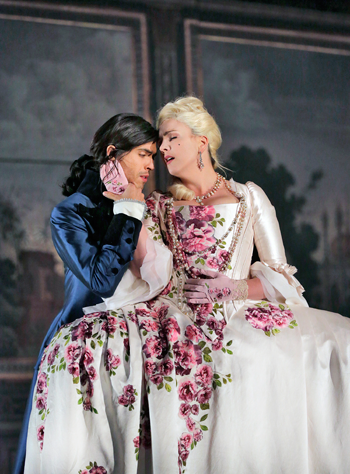 Susanna Phillips as Arminda and Joel Prieto as Count Belfiore
Susanna Phillips as Arminda and Joel Prieto as Count Belfiore
I first encountered soprano Heidi Stober at Opera Theatre of Saint Louis where I thought she was remarkably fine. In the intervening years, Ms. Stober has grown even more and on this occasion, her Sandrina was individualized, poignant, musically faultless, and fully realized as a wonderfully complex character. She did not sing the part so much as inhabit it. Her poised, warm instrument had enormous appeal.
Providing welcome balance, Laura Tatulescu combined sass and pointed singing to create an edgy, confrontational impression as the sharp-tongued Serpetta. It is to her credit and skillful technique that Ms. Tatulescu is able to craft a personality that is acerbic, without the vocals turning acidic. Her clear, rhythmically assured singing was a pleasure and she clearly relished her comic opportunities and wrung every bit of firebrand potential out of the role.
Joshua Hopkins is a suave performer, with a rich, manly baritone, evenly produced with a suggestion of plush velvet. His Nardo was a perfect foil for Serpetta and they created real sparks between them. Mr. Hopkins knows how to command the stage and his physical presence was as handsome as his vocalizing. Cecelia Hall effected just the right hangdog look to engage our sympathies as Ramiro, and her creamy singing was vibrant and characterful. Even in such a less developed role, Ms. Hall more than held her own in this polished ensemble.
Susanna Phillips took obvious delight in playing Arminda, the opera’s Queen of Mean. She found ample excuses to unleash pointed phrases styled with laser-like accuracy. Yet she resisted delving into caricature, and she also lavished us with singing of amplitude and richness. Ms. Phillips’ disciplined vocal portrayal was nevertheless wedded to a sense of spontaneity thanks to her canny acting.
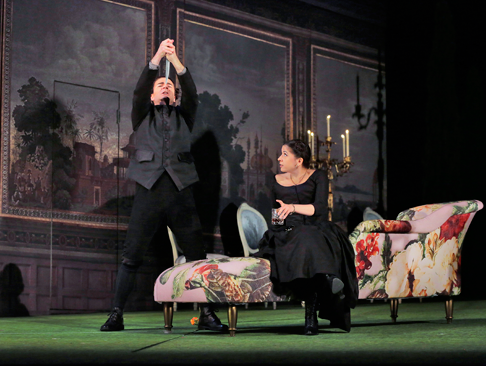 Joshua Hopkins as Nardo and Laura Tatulescu as Serpetta
Joshua Hopkins as Nardo and Laura Tatulescu as Serpetta
Rounding out that cast as Count Belfiore, Joel Prieto offered witty, fluid phrases that were well served by his congenial tenor. Mr. Prieto, too, had a good sense of fun and a loose, easy stage presence. His flexible technique and appealing bright timbre suited the role, although there may be more to be mined in the complicated Count.
Tim Albery has directed with simplicity and clarity. His fluid movement of the actors was highly effective, and the shifting pairings-up, and squarings-off of the cast were brilliant. The whole evening played out as a balletic cat and mouse game with roles, and advantage of positions, in constant flux.
Hildegard Bechler has certainly done her part to ensure the evening’s success with a set design that is at once functional, mysterious, bare bones, and profound. There is an arching wall stage left that is impeccably detailed with an ornate tromp l’oeil recreation of a period palace hall. Chairs with upholstered seats stand against the wall, while a large dining room table sits center stage. This functions as occasional meeting place where character some together, or as a barrier, keeping characters apart.
About two thirds of the stage is covered with lush green Astroturf-as-carpeting, abutted by the requisite garden which takes up the down left area. The rust and yellow flowers (many planted by Sandrina in Act One) are a beautiful balance as they encroach on the formal interior. The dining table is replaced in Act Two by a chaise lounge, which got cleverly incorporated into the staging.
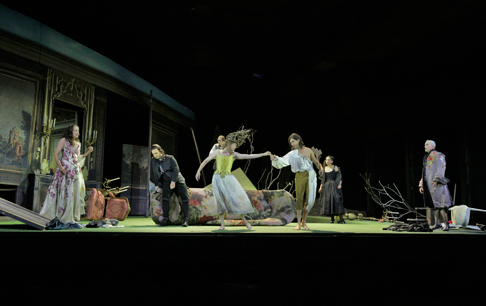 The ensemble
The ensemble
Jon Morrell created totally apt costumes that aided greatly in the characterizations, black and severe for the servants (including the phony farmerette), and sumptuous for the nobles. The incorporation of floral images in such things as Arminda’s dress and the tablecloth only added to the cheeky visuals. Thomas C. Hase’s slowly unfolding lighting effects were mesmerizing. The extremely deliberate cross fade from sunny exterior to moody interior in the first act was stunning.
Every element of La finta giardiniera was committed to showing that this talented group absolutely believed in the worth of this piece. And damn, if ultimately they didn’t succeed in making me believe in it, too!
James Sohre
Cast and production information:
Sandrina: Heidi Stober; Serpetta: Laura Tatulescu; Ramiro: Cecelia Hall; The Podesta: William Burden; Nardo: Joshua Hopkins; Arminda: Susanna Phillips; Count Belfiore: Joel Prieto; Conductor: Harry Bicket; Director: Tim Albery; Set Design: Hildegard Bechler; Costume Design: Jon Morrell; Lighting Design: Thomas C. Hase.
image=http://www.operatoday.com/6-Heidi-Stober-%28Sandrina%29-and-William-Burden-%28Podesta%29-in-%E2%80%98La-Finta-Giardiniera.%E2%80%99-Photo-%C2%A9-Ken-Howard-for-Santa-Fe-Opera%2C-2015.png
image_description=Heidi Stober as Sandrina and William Burden as the Podesta [Photo by Ken Howard]
product=yes
product_title=Santa Fe: Secondary Mozart in First Rate Staging
product_by=A review by James Sohre
product_id=Above: Heidi Stober as Sandrina and William Burden as Podesta
Photos by Ken Howard
Regimented Daughter in Santa Fe
After a sparkling, infectious overture, expertly led by Speranza Scappucci, a Les Miz style barricade rotates to reveal the choristers, not in colorful folk costumes, but in severely styled black funeral wear (think: Amish look).
Belying the set-up of the sprightly overture, director Ned Canty got things off to a rather somber start, more William Tell than Donizetti’s comic opus. After this stolid beginning, Mr. Canty seemed to have second thoughts, and in short order the tale gets liberally peppered with the usual (and some unusual) shameless jokes and inspired (and some uninspired) physical comedic schtick, and then some. Canty wrote the English dialogue with the music sung in the original French.
Allen Moyer’s sets and costumes were quite witty and adaptable. The barricade of Act I yields furniture and props that cleverly get plucked off the pile, and there are ample levels to create interesting stage pictures. The ornate false proscenium, hunter green with panels painted with Tyrolean scenes, created a sense of place and established a highly theatrical style. A stylish carriage conveys the Marquise on- and off-stage. The Berkenfeld manse of Act II is sumptuous inside and out, its exterior paraphrasing Linderhof. Rick Fisher’s efficient lighting design was up to his usual high standard.
After the drab opening attire, Mr. Moyer’s costumes add color little by little, first with red and blue uniform jackets, then with Tonio’s red and black Trachten, later with lavish party gowns. Marie’s over-the-top pink dress for the Lesson Scene was a riot of invention and that scene crackled with good humor. And then the director seemed to change his mind again with the mood becoming soul-searching, earnest, and well, a bit ponderous. By the time he changed his mind yet again with the interpolated and extraneous announcement of silly German names and titles of all of the party guests, the Duchess of Krakenthorp was thoroughly pre-empted and upstaged.
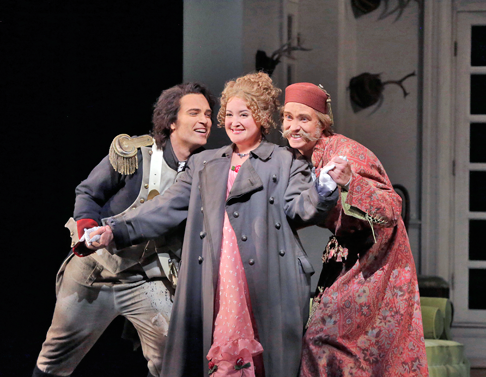 Alek Shrader as Tonio, Anna Christy as Marie and Kevin Burdette as Sulpice-Pingot
Alek Shrader as Tonio, Anna Christy as Marie and Kevin Burdette as Sulpice-Pingot
By that point, the return to frivolity was too little too late. Self-indulgence marred Act II with too many lilies being gilded with too much “added material,” too much deference to the (secondary character) Marquise’s “feelings,” and too little regard for pacing in what is, after all, a pretty slight comedy. By removing non-essential business, tightening the repetitious dialogue, keeping the focus on Marie-Tonio, and urging the pace along, about ten minutes could be taken off the second act and the show would be even better than the audience already thinks it is.
Whatever the (only) occasional longueurs of the staging, Maestra Scappucci snapped the proceedings back into focus every time her authoritative baton came down, eliciting a reading of the score that was characterized by audacious spontaneity, effervescence and a keen sense of style. The conductor not only admirably partnered her singers with breadth and flexibility on poignant arias, but also took firm control over such tricky allegro passages as that breathless account of the Act II trio Tous les trois réunis. Clearly, the talented Speranza Scappucci is a podium star on the rise.
A lot is asked of the four principles in carrying The Daughter on their backs, and they did not disappoint. The great Beverly Sills once described the vivandière Marie as “Lucille Ball with high notes.” Just as we all loved Lucy, we were enchanted by pretty, perky and petite Anna Christy who proved a natural as the canteen girl, a supposed orphan who has been “adopted” by the 21st Regiment.
Ms. Christy takes the stage as an unapologetic tomboy and shows off awesome comic timing. Adding to the appeal, she also has a finely spun, meticulously schooled, silvery soprano of great agility and admirable range. While she offers sparkling vocalizing throughout the evening, it is in the slower arias that she finds the most personalized tone and most engaging pathos. If I had one wish for Anna, it might be to eliminate a few of the held notes in alt. The couple of thrilling successes were offset by a few that wanted to splay. When you are as accomplished as this, when we are already eating out of your hand, when we wouldn’t miss the additional stratospheric notes, why take chances? That minor quibble aside, Anna Christy is giving a wholly accomplished star performance.
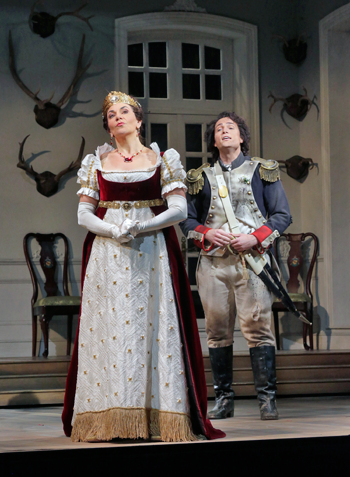 Phyllis Pancella as the Marquise of Berkenfeld and Alek Shrader as Tonio
Phyllis Pancella as the Marquise of Berkenfeld and Alek Shrader as Tonio
Alek Shrader is easily the funniest Tonio of my experience. From his first entrance, picture postcard handsome in his Tyrolean get-up, he immediately betrays a puppy dog eagerness and gangliness that is consistently appealing. His physical comedy was superb. When he tried to be Joe Cool, listening to Marie’s story, he kept feigning casual positions that were impossible to maintain, with one of these finding him clinging to the barricade and dangling like a dyspeptic monkey.
Mr. Shrader’s singing was assured and correct, although the tone has taken on a slightly veiled quality since last I heard him. He has a fine sense of legato, to be sure, and he injects personality and purpose into all he sings. The very top notes thin out a mite these days, and while he certainly had the goods for “Mes amis,” he lacked that final ounce of real distinction. Like his co-star, he scored decisively in such touching moments as Pour me rapprocher de Marie, in which his beautiful instrument, comfortable tessitura, and heartfelt intent magically merged.
As Sergeant Sulpice, it was hard to believe that Kevin Burdette was the same performer who was so serious and compelling in Cold Mountain some days prior. Here, he was all loose limbs and German-challenged orator, a marriage of Dick Van Dyke and Mr. Magoo. Forget about solar panels, Mr. Burdette generates enough energy to power greater Santa Fe. That he also sang with a direct, polished delivery was icing on the pratfall.
Far from the usual dotty Marquise de Berkenfeld, Phyllis Pancella offered a glamorous and elegant interpretation. If her ripe mezzo has gained a more mature sheen over the years, she remains a very gifted singer. Her craft is on full display as she deftly utilizes a change of registers to underscore comic shifts in her musical lines. Moreover, she proved herself once again to be a fine comedienne, delivering her lines with an endearing self-importance, while mugging with a vaudevillian’s understated expertise.
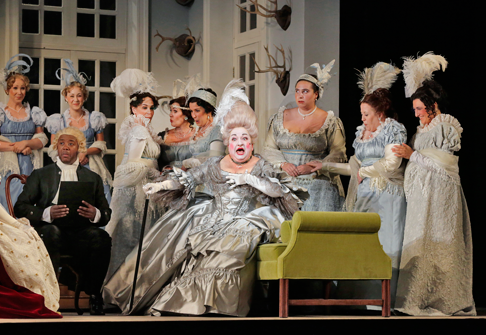 Judith Christin as the Duchess of Krakenthorp
Judith Christin as the Duchess of Krakenthorp
The accomplished singer Judith Christin seemed wasted as the Duchess of Krakenthorp. Heavily made up in clown white greasepaint and overstated features, got up in an over-the-top silvery-white gown, and topped with an ostentatious wig, when Ms. Christin spoke in her distinctive contralto and rasped an exhortation with a heavy German accent, she could have been a man in drag. She did all that was asked of her with conviction to be sure, but I for one wish more had been asked.
Apprentice Calvin Griffin offered an imposing, handsome presence and sang with an assured bass-baritone as the servant Hortensius. Susanne Sheston had the chorus singing with gusto and personality. Seán Curran crafted some delightful, natural choreography, especially the Regiment’s fist pounding “salute” that delectably recalled the hand jive.
All in all, this Daughter had quite a successful romp across the SFO stage, but when she got too regimented and moody I just wish someone had told her to lighten back up.
James Sohre
Cast and production information:
Hortensius: Calvin Griffin; Marquise of Berkenfeld: Phyllis Pancella; Peasant: Jack Swanson; Sergeant Sulpice Pingot: Kevin Burdette; Marie: Anna Christy; Tonio: Alek Shrader; Corporal: Adrian Smith; Duchess of Krakenthorp: Judith Christin; Notary: Jorell Williams; Conductor: Speranza Scappucci; Director: Ned Canty; Set and Costume Design: Allen Moyer; Lighting Design: Rick Fisher; Choreographer: Seán Curran; Chorus Master: Susanne Sheston; English Dialogue: Ned Canty.
image=http://www.operatoday.com/21-Anna-Christy-%28Marie%29-in-%27The-Daughter-of-the-Regiment.%27-Photo-%28c%29-Ken-Howard-for-The-Santa-Fe-Opera%2C-2015.png
image_description=Anna Christy as Marie
product=yes
product_title=Regimented Daughter in Santa Fe
product_by=A review by James Sohre
product_id=Above: Anna Christy as Marie
Photos by Ken Howard
Santa Fe’s Celebratory Jester
Like SFO itself, the Verdi opus proved to be evergreen.
This was owing in no small part to a high-powered cast that would be at home on any world stage. In the title role, Quinn Kelsey served notice that he surely has few contemporary equals in this demanding part. Mr. Kelsey dominated the proceedings from his first appearance, not only with a hulking physical presence but also with a superlative baritone that had urgency and menace.
His measured, sarcastic barbs were served up with a honeyed malice, and his introspective musings had a possessed, haunting humanity. In the duets with his daughter, his opulent legato conveyed a depth of feeling not often captured by other interpreters. His was a top tier performance of one of the greatest baritone roles in the canon.
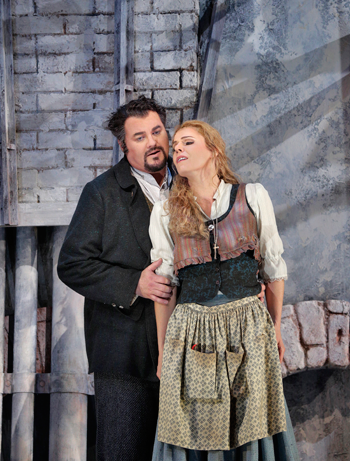 Bruce Sledge as the Duke of Mantua and Georgia Jarman as Gilda
Bruce Sledge as the Duke of Mantua and Georgia Jarman as Gilda
As Gilda, Georgia Jarman matched him in every respect, displaying a sizable lyric soprano, capable of great nuance and color. The hints of gold in her upper register conveyed a youthful, infatuated girl in her first scene, while the touch of tremulous intensity in lower ranges communicated her conflicted disobedience of her father’s wishes.
After the Duke rapes Gilda, Ms. Jarman infused the sound with a touching despair, then maintained a firm resolve to the end. Her delicate, ethereal singing in the final bars was not meant for mere human ears; it was ravishing and heartbreaking.
Bruce Sledge brings such a secure lyric tenor to the Duke of Mantua, so lovingly produced that you could almost be seduced that he is not a shitheel. Mr. Sledge has all the notes in his arsenal and then some, and he sings the famous arias and the treacherous quartet with abandon. His acting and vocal coloring are a bit generalized but he is never unengaged. Time and experience will allow this talented singer to find his own unique qualities that he can bring to the role.
Apprentice Peixin Chen was sonorous and unctuous as the villainous Sparafucile. His rich, dark bass poured forth effortlessly, and he had a fine stage presence. As his sister (and murderous cohort) Maddalena, Nicole Piccolomini pinned our ears back with a steely mezzo of substantial size and import. Although not announced as indisposed, there seemed to be hints of a troubling rasp to some attacked phrases. Still, Ms. Piccolomini gave an assured performance.
Robert Pomakov was a coiled spring of a Monterone, his thunderous bass frightening in its intensity. Young artist Jarrett Ott took advantage of every note the master wrote for Marullo and sang with a solid, attractive baritone. Shabnam Kalbasi similarly imbued Countess Ceprano’s critical phrases with poised, attractive singing. Anne Marie Stanley made much out of Giovanna with sassy, classy vocalizing and a well-rounded characterization.
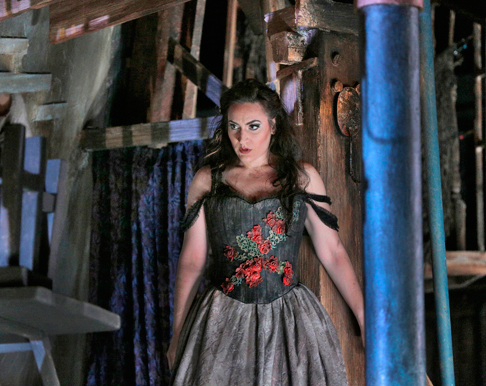 Nicole Piccolomini as Maddalena
Nicole Piccolomini as Maddalena
From Jader Bignamini’s first downbeat, the conductor led a propulsive, taut reading weighted with dramatic conviction. The foreshadowing of the curse in the prelude has never seemed so urgent. Maestro Bignamini crafts a thrilling dramatic arc to the familiar score that not only moves forward inexorably but also takes time to relish subtleties in the diverse emotional journeys of the characters. Susanne Sheston has the marvelous chorus trained to a fare-thee-well.
The physical production could hardly have been better. Adrian Linford does double duty as Set and Costume Designer and excels at both. The production has been placed in the time of its composition. To solve the challenge of the multiple settings required within the limits of the SFO stage, Mr. Linford has crafted a marvel of a rotating structure that is a veritable kaleidoscopic collage of stairs and colonnades and fences and windows and chambers, all slightly askew, and all multi-functional. The colors, textures and architectural fragments skillfully evoke Mantua.
Mr. Linford’s costumes are very inventive, especially for the jester, decked out in a large overcoat, with a Charlie Chaplin hat, thick orthopedic shoe on one foot, and a false vest front that Gilda helps him change out during their first duet. Courtiers look sufficiently wealthy but with a patina of debauchery. The women are mostly got up (or not clothed much at all) as lurid, willing and available sex objects. Giovanna is an abused maid who has a visible syphilis scar on her pallid face.
This is a crumbling, decadent environment, tellingly lit with a twilight-of-the-gods finality by Rick Fisher. Within this effective visual environment, Director Lee Blakely directs a straight forward, no-nonsense telling of the tragedy that is breathtaking in its accurate simplicity. Mr. Blakely has crafted an evening of movement and interaction that is always true to the story and that clarifies the shifting dynamics of mood and character development. His use of the many available levels creates visual interest and variety. When he does inject some innovative sub-text, it pays handsome dividends.
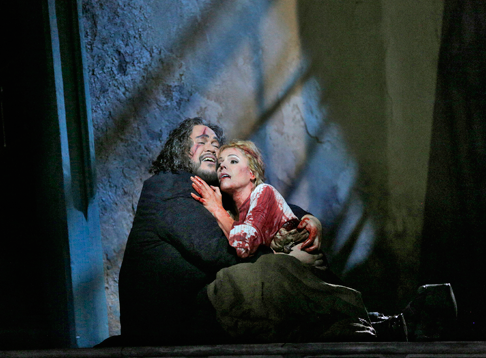 Quinn Kelsey as Rigoletto and Georgia Jarman as Gilda
Quinn Kelsey as Rigoletto and Georgia Jarman as Gilda
The usually forgettable maid Giovanna is a case in point. Blakely’s take is that she is a spectral, unhappy (perhaps abused) creature, who appears to be starving. Her complicity in tricking Rigoletto is born of revenge, and after Rigoletto sinks to his knees with the realization that his daughter has been kidnaped, she spits on him as she stalks off. It is such attention to detail, and commitment to honest interplay that makes this a near perfect “Rigoletto,” shattering in its cumulative effect.
I can’t think of a better two-thousandth milestone present than this fine evening of opera with the company operating on all cylinders at its very best.
James Sohre
Cast and production information:
Duke of Mantua: Bruce Sledge; Borsa: Adrian Kramer; Countess Ceprano: Shabnam Kalbasi; Rigoletto: Quinn Kelsey; Marullo: Jarett Ott; Count Ceprano: Calvin Griffin; Count Monterone: Robert Pomakov; Sparafucile: Peixin Chen; Gilda: Georgia Jarman; Giovanna: Anne Marie Stanley; Monterone’s Daughter: Andrea Nunez; Court Usher: Michael Adams; Maddalena: Nicole Piccolomini; Conductor: Jader Bignamini; Director: Lee Blakeley; Set and Costume Design: Adrian Linford; Lighting Design: Rick Fisher; Choreographer: Nicola Bowie; Chorus Master: Susanne Sheston.
image=http://www.operatoday.com/19-Quinn-Kelsey-%28Rigoletto%29-in-%27Rigoletto.%27-Photo-%28c%29-Ken-Howard-for-The-Santa-Fe-Opera%2C-2015.png
image_description=Quinn Kelsey as Rigoletto [Photo by Ken Howard]
product=yes
product_title=Santa Fe’s Celebratory Jester
product_by=A review by James Sohre
product_id=Above Quinn Kelsey as Rigoletto
Photos by Ken Howard
Sibelius Kullervo, BBC Proms, London
Sakari Oramo considers Kullervo “a masterpiece”, and, at Prom 58 at the Royal Albert Hall, London, conducted it with such conviction that there can be little doubt about its unique place in Sibelius’s output, and indeed in music history.
Kullervo is such a remarkable work, so shockingly original that Paavo Berglund revisited it fifteen years after his original recording. Neeme Järvi brought yet more new insights. There have been many other performances since, but Sakari Oramo creates an interpretation of great depth and perceptiveness.
From a hushed opening, the Allegro Moderato grew with ever increasing impatience, as if it were an Overture to an opera, for a quasi-opera this is. One cannot underestimate the impact of Wagner and his “forest murmurs”, though even at this early stage in his career, Sibelius was iconoclastic, deliberately seeking a new sound world. Unlike Wagner who re-imagined Norse legend, Sibelius heard living oral tradition at first hand. Kullervo comes alive with the rhythms of the Kalevala, with its strange, primitive pulse and shamanistic repetitions. Hence the short, sharp intervals in the brass and winds, and the driving pizzicato in the strings, creating a sense of tense, ritualized movement. Even to our ears accustomed to Stravinsky, Bartók and Janáček, Kullervo still sounds raw and primeval. Yet it was written twenty-one years before The Rite of Spring
I’ve often wondered if Sibelius himself realized how daring Kullervo was and, being a worrier, pulled back, as he might have pulled back from the enormity of his conception for the Eighth? Once, Sibelius performance history presented the composer in sub-Tchaikovsky terms, which really doesn’t do the composer justice. Kullervo resets the balance so we can think ahead to the Fifth and Seventh Symphonies and their audacity and inventiveness It is, unequivocally new and individual, the mark of a true genius.
In Kullervo, we can hear the origins of tone poems like Nightride into Sunrise and Lemminkäinen Suite. and reflect that the tone poems are much darker than mere portraits of Nature and myth. Thus the lucid detail of Oramo’s conductng, which emphasizes the sophistication that lies beneath the ostensible savagery in the piece. It’s not simply a folk tale for grand orchestra but an experimental approach to dynamics and relationships. The contrast between emotional extremes and the tight, staccato-like intervals creates abstract narrative tension. Oramo makes the orchestra “sing” as if we’re hearing Kullervo’s nervous heartbeat, pulsating with frustration.
Kullervo is also a musical act of defiance, written as it was at a time when Finland was resisting efforts by Russia to curb its freedoms. This adds context to the figure of Kullervo himself, a child born into suffering. One can appreciate Kullervo without knowing the Kalevala, but it does enhance meaning. Runes XXXI to XXXVI give Kullervo’s background. He’s cruelly mistreated by an uncle who stole his patrimony. He’s tortured and sold into slavery. When he meets the maiden, he rapes her because he wants what she represents, yet, raised in cruelty, he doesn’t have what we might call “social skills”. Dreams of his long-lost mother have kept him going , so when he discovers that the woman he has violated is his sister, he suffers such guilt that he must offer his own life in appeasement.
Johanna Rusanen-Kartano sang Kullervo’s sister. She’s a very good dramatic soprano, with the intensity to remind us that the girl, too, has had a traumatic past, lost in the woods while hunting for berries. Her story is as tragic as her brother’s. Rusanen-Kartano’s lines were rapid-fire tongue twisters, delivered with absolute precison and bite. Later her lines curve sensuously,but even in these beautiful moments, she retained a mysterious quality as if the girl had been led into the forest by evil spirits, represented perhaps in the clarinets and pumping woodwind around her. Waltteri Torikka sang the baritone part. He didn’t have quite the assurance of, say, Jorma Hynninen, but he can express the vulnerability that lurks behind Kullervo’s brutishness. If his voice didn’t project well, live, in the cavern that is the Royal Albert Hall it sounded better on broadcast. There’s potential in this voice.
In Kullervo, the choir (the Polytech Choir augmented by the men of the BBC Symphony Chorus) operate like a Greek Chorus commenting on proceedings and adding ballast to the orchestra. These choral parts are difficult, for the lines flow with little pause for breath, relentlessly moving the action forward. The Finnish language, too, poses problems. Every vowel sound must be articulated, and there are vowel sounds one after another in succesion, cut across with stinging sibillants. “Kullervo, Kalevon poika, sinisukka äijön lapsi,”. For the Polytech Choir from Helsinki, the lines flow seamlessly, yet are energized by high testosterone punchiness. We can hear the fast-moving sleigh, complete with bells as it rushes “noilla Väinön kankahilla, ammoin raatuilla ahoilla”. Yet these rhythms also suggest violence, the relentless course of fate, and lets face it a fairly explicit description of sex. I was fascinated by the way the choir varied their emphases, dropped to whispers and rose to full volume, and the variety of subtle expression.
In London, we hear the BBC Symphony Orchestra all the time, so we take them for granted, and forget how good they really are. The Alla marcia (Kellervo goes to war) isn’t difficult for players with these technical skills, but they played with energy and vigour. Oramo marked the end of the battle with a long silence, soon the voices of the male choirs returned, ghost-like. Muted large brass, tuba and trumpets muffled, bassoons sighing, clarinets rising like smoke on a battlefield. While Kullervo begins characterized by hard, angular sounds, and breaking off painfully into silence, the final movement, Kullervo’s Death, is an andante. The timpani were beaten in slow march, placed at a distance from the rest of the percussion, cradling the orchestra, perhaps, in the kind of embrace Kullervo never knew. Sibelius didn’t set the last lines of Rune XXXVI but he and his audiences would have known the moral with which the saga ends. It is a warning that children should not be abused or mistreated.
Starting with a very good En Saga (Op 9, 1892 rev 1902), this was by far the most-focused and well performed Sibelius this season, making up for a patchy, and diisappointing symphonic cycle in earlier Proms. .
Anne Ozorio
image=http://www.operatoday.com/Kullervo-Goes-to-War-Akseli-Gallen-Kallela.png
image_description='Kullervo Goes to War' by Akseli Gallen-Kallela
product=yes
product_title=Sibelius Kullervo, BBC Proms, London
product_by=A review by Anne Ozorio
product_id=Above: 'Kullervo Goes to War' by Akseli Gallen-Kallela
August 28, 2015
Aïda at Aspen
The title role was taken by the young American soprano Tamara Wilson, who received accolades as a replacement Aïda at the MET last December. Wilson’s cool and silvery soprano reminds one of great interwar Aïda’s—Elizabeth Rethberg comes to mind—rather than Leontyne Price, Maria Callas, Renata Tebaldi or other postwar singers who have led us to expect broad warm, darkly golden-toned voices in this role. (Wilson even looks a bit like something out of an early 20th century photograph—which I mean as a compliment.) Wilson’s voice is so perfectly focused that at pianissimo it can easily fill even an acoustically problematic space such as Aspen’s large tent, yet it can also swell to a thrilling forte, and beyond to fortissimo—all without spoiling the timbre or line. The technical difficulties of the role—including the dolce high c in “O Patria Mia,” which only a few singers per generation can really sing as written—pose for her no problem. Her clear diction, subtle inflection and musical intelligence, combined with an ability to act with her face, added up to coherent musical-dramatic characterization of the title character: more girlish and vulnerable than one generally sees. As she ages, the voice may fill out further, particularly at the bottom. If so, Wilson may become an Aïda for the ages.
As Ramfis, Morris Robinson commanded the stage even when sharing it with one hundred others. His thundering cries of “Guerra!” rang above the first scene concertante finale, his sonorous bass floated just audible above the opening chorus of the second scene, his subsequent high f at “Folgore morte” was firm, and so on through the night. He acted equally well: his looming presence added an ominous element to the Egyptian priesthood and his quick glances signaled that he was on to Radamès and Aïda long before anyone else. Diction is the only area in which Robinson could improve, but this former all-American football player who began singing opera seriously only at 30, is already more than repaying the early faith of the Met and other companies.
At least at this stage in his career, Brian Mulligan wisely rejects the gruff bluster with which most baritones approach Amonasro in favor of scrupulous and sensitive attention to the score. His approach was evident from his opening declaration (“suo padre!”). Most baritones announce their belated presence with a ringing forte at this point, which makes some dramatic sense for a king in disguise. Yet Mulligan sang it as Verdi plainly wrote it in the score: forte at first, but with a lovely, almost reflective, decrescendo. Elsewhere Mulligan’s scrupulousness and sensitivity paid dividends as well, particularly in the Act III duet with Aïda. Here again we may have the makings of a heavyweight Verdi greatness.
The fourth young singer, tenor Issachah Savage, clearly possesses that rare operatic gift: a near-ideal natural instrument to sing Radamès. He possesses bronze-hued grandeur for the heroic passages and a sweetly mixed timbre for the more intimate ones. Though he has been singing this role for several years, however, nervousness seemed to undermine his big moments. He cut off many extended and exposed phrases, sagged flat and dropped a line in “Celeste Aïda,” and failed to produce a clear tone on both the final A of Act 3 and the penultimate pianissimo B-flat of Act 4. Still, this young Philadelphian is a singer to watch; he may yet achieve historical greatness in spinto and dramatic roles.
The fifth lead singer, Mezzo Michelle DeYoung, was by far the most experienced and best-known singer on stage. She is a consummate professional. The voice is even and smooth from top to bottom and the diction clear. She looks the part and she has clearly thought out the musical-dramatic effects she seeks at every point: her portrayal of Amneris is more sympathetic than the scenery-chewing norm. Yet in the end one wonders if this is really the right role for someone without the requisite chesty mezzo power and steely edge of a classic Verdi mezzo, particularly at the extremes of the voice. She simply failed to command the stage at Amneris’s grandest moments: the Act II duet and, above all, the end of the Judgment Scene, where the ultimate high A is made to ring out more powerfully and longer than the strict four beats in Verdi’s score.
As for the smaller roles, Pureum Jo delivered the Sacerdotessa’s exotic lines smoothly but (whether due to placement or intent) too loudly: the temple priestess’s voice is supposed to emerge mysteriously and exotically from somewhere in the darkness of a vast temple, which is why Verdi marked it to be subtle and soft, even though off-stage. Bass Matthew Treviño and tenor Landon Shaw II used strident declamation, good diction and excellent acting—not to mention the appearance of handsome young mafiosi—to make the most of their cameos as the King and the Messenger.
Given that they (I am told) less than a week and few rehearsals, the Aspen Festival Orchestra under Robert Spano performed with remarkable fluidity, accuracy and idiomatic style. To be sure, the orchestra contains ringers, such as Elaine Douvas (Principal Oboe of the Metropolitan Opera) and David Halen (Concertmaster of the St. Louis Symphony), who can handle this material in their sleep. But it also includes top students and young professionals, who acquitted themselves impressively. (No lack of a younger generation among orchestral musicians, evidently!) Only the triumphal trumpets in the higher key struggled. The chorus sang lustily, but also with subtlety when it mattered most. Spano directed well, only occasionally proceeding with excessive caution. By necessity, a semi-staged production will emphasize the intimate aspects of this opera, which took place within a hollow cloth pyramid, open on the side facing the audience. It made for an adequate, though not impressive, set. Comic relief was provided in the Triumphal Scene by permitting a half dozen very large white balloons bounce around the audience, as the principals—still inhabiting the world of 5000 years ago—watched bemused from the stage.
Andrew Moravcsik
image=http://www.operatoday.com/tamara-wilson-279-edit.png image_description=Tamara Wilson [Photo by Aaron Gang courtesy of Columbia Artists Management Inc.] product=yes product_title=Aïda at Aspen product_by=A review by Andrew Moravcsik product_id=Above: Tamara Wilson [Photo by Aaron Gang courtesy of Columbia Artists Management Inc.]Prom 53: Shostakovich — Orango
Flags were fluttering feverishly in the Arena and Gallery; the orchestra sported festive red sashes and the conductor had swapped his tuxedo for a lurid orange ti-shirt print-stamped with a hammer-and-sickle and an outsize portrait of Stalin; jazz mingled with brassy fanfares — and I was sure at one point that I heard a snatch of ‘Rule, Britannia!’. Had the ‘Last Night’ come early? No, we were being invited to embrace the bizarre and grotesque world of Dmitri Shostakovich’s unfinished (1932) opera, Orango.
Having just read Joanna Burke’s wide-ranging and thought-provoking investigation into What It Means to Be Human (Virago, 2011) — following Bourke’s arguments down the scientific, ethical and political byways of speciesism, xenografts and cross-transplantation — it seemed fitting to find myself watching the Prologue of an opera by Shostakovich in which the protagonist is a half-man/half-ape hybrid — the result of a grotesque medical experiment — who now resides in a Moscow circus and who is brought before the jeering crowds so that they can marvel at his dexterity with knife and fork, the civilised manner in which he blows his nose and yawns, and his musical prowess at the piano keyboard.
Orango was commissioned by the Bolshoi Theatre in 1932 to celebrate the 15th anniversary of the October Revolution, and the creators were given a broad theme to motivate them: ‘growth during revolution and socialist construction’. But, rather than producing a straightforward warning against the dangers of Western capitalism, Shostakovich and his collaborators devised a biting satire — recalling Mikhail Bulgakov’s allegorical novel Heart of a Dog — on the Communist Revolution’s attempt to radically transform mankind, and on the utopian science of the 1920s. One of the sources of inspiration for Shostakovich and his librettists, Aleksey Tolstoy (the ‘Red Count’) and Alexander Starchakov (who was arrested and executed by Stalin in 1937), was probably the work of the Russian biologist, Ilya Ivanovich Ivanov who attempted the hybridization of humans and other primates, chiefly chimpanzees. Shostakovich is reported to have visited Ivanov’s primate research station in Sukhumi while holidaying near the Black Sea.
Originally planned as a three-act opera, only the Prologue survives (though who knows what may subsequently turn up in the recouped refuse …). The manuscript was found by Russian musicologist Olga Digonskaya — who had been working with Irina Shostakovich, the composer's third wife and widow, on Shostakovich's catalogue — in the Glinka State Central Museum of Musical Culture, Moscow in December 2004. Digonskaya discovered a cardboard file containing some hundreds of pages of musical sketches and scores in Shostakovich’s hand. The story goes that a composer friend bribed Shostakovich’s housemaid to salvage the contents of his waste bin, thereby saving potential compositional gems from the garbage, and that some of this ‘rescued rubbish’ made its way into the Glinka Museum: among the ‘detritus’ were 13 pages of Orango — about 35 minutes of music. A piano score was published in 2010, with a scholarly introduction by Digonskaya, and this was later orchestrated by Gerard McBurney.
From these beginnings Finnish conductor Esa-Pekka Salonen has consistently championed Orango, giving the premiere of the Prologue in Los Angeles in December 2011 (with the Los Angeles Philharmonic, and staged by Peter Sellars; a live recording was released by Deutsche Grammophon in 2012), bringing it to Europe in May 2013 (with the Philharmonia Orchestra at the Festival Hall London), and taking the opera back home to Russia in April 2014, where he conducted the London Philharmonic Orchestra and the Yurlov Russian State Academic Choir in a concert at Moscow’s Conservatory, as part of the International Rostropovich Festival.
In the Prologue, the Master of Ceremonies recounts Orango’s tale before the crowds at the Palace of Soviets, Stalin’s monumental but ultimately unrealized skyscraper — just one of the busy projections beneath and around the RAH organ balcony (stage/video design, Louis Price) which accompanied the performance. The MC relates how, after serving heroically in World War I and finding riches as an anti-communist journalist and newspaper mogul, Orango went bankrupt in an international financial meltdown and, as his behaviour was becoming increasingly simian and brutal, has been sold to the Soviet Circus. Hearing this news, and dissatisfied with the entertainment offered by a famous Russian ballerina, the impatient and increasingly bacchanalian crowds demand that Orango be brought before them. The man-primate is duly paraded but he becomes agitated and aggressive when he espies a young woman with red hair, Suzanna (who was to have been revealed later in the opera as his ex-wife). Another ballet display sends Orango wild with exasperation — ‘I’m suffocating, suffocating under this animal skin’ (here, Orango and the ballerina had a face-off over an outsized red Kalashnikov) — and the show is stopped, as the embryologist, his daughter and a foreign journalist all make claims to have a connection with Orango. The Prologue concludes with the crowd’s hysterical chant, ‘Laugh! Laugh!’, as the ape-man struggles for breath.
The Philharmonia Voices enthusiastically launched proceedings with a choral anthem celebrating the ‘freedoms’ of the new Soviet ages, with the miseries of pre-Revolution misery, their voices gusty, their copies of Pravda thrust heartily aloft. Later they would waft sunflowers and punch the air with similar panache.
As the Master of Ceremonies charged with entertaining the crowd of bored Foreigners — alien capitalists from the West — bass Denis Beganski was nattily dressed in blue silk but slightly woolly of voice, although his patter song eulogizing the miracles of the new Soviet economy went with a swing. Faced with the Foreigners’ demands for ‘something more interesting’, the MC summoned ‘the USSR’s most famous ballerina’, Nastya Terpsikhorova (Rosie Kay) whose ‘Dance of Peace’ was tidily executed. Dressed in a furry costume that looked decidedly itchy, tenor Ivan Novoselev effectively conveyed Orango’s unpredictability and the pathos of his situation. Dmitro Kolyeushko acted well as the Zoologist, more interested in his bananas than in the beast with whose care he is entrusted. As Suzanna, Natalia Pavlova was vocally strong and dramatically engaging. The ‘Foreign Visitors to Moscow’ looked like a strange troupe of grotesques but made consistently sure, if fairly minor, individual contributions.
Salonen and the Philharmonia had great fun with this outrageous and uproarious score. There was much impressive playing from the brass, percussion, bassoons and flutes in particular. Characteristically, there’s a lot of self-quotation — with music from The Bolt, Hypothetically Murdered and Lady Macbeth of the Mtsensk District among the many Shostakovich works making an appearance. It’s also an eclectic mix of idioms: a potpourri of can-cans, cabaret and children’s nursery songs — a veritable Orango-Tango mélange. But, we were never permitted to forget that Shostakovich’s satire is serious stuff: the musical mix may be wild, but there’s a grim blackness too. If the musicians’ approach was fearless, then we were reminded by this focused, intense performance that at this stage in his career Shostakovich was similarly daring; in music, as in life.
The 1932 commission was not delivered to deadline, and the opera was apparently abandoned: perhaps Shostakovich was distracted by his concurrent work on the scores of Lady Macbeth of the Mtsensk and the Fourth Symphony, or perhaps the creators recognised that their sharp lampooning of Social Realist ideology and spectacle would not go down very well with Stalin’s cronies in the Kremlin. Acts 1 to 3 would have told, in flashback, the full story of Orango’s life from his creation to his arrival in the USSR; all we have is this zany preface — which in fact suggests that considerable work would have been needed to tighten up the dramatic structure. These ‘opening’ 40 minutes are rather aimless: Orango’s story was to have been told in flashback in the following three acts, but on the evidence of the Prologue the overall result might well have been chaotic rather than coherent. The Prologue is certainly ‘all action’; and, in this staging the performers used the whole space of the auditorium, entering by various stairways and parading the aisles. But while the score repeatedly tickles — and electrifies — the ear, the hypermania serves little purpose and the cast have nothing much to actually ‘do’, resulting on this occasion in several long ‘freeze-frames’ as the soloists stood stock still during long orchestral episodes.
But, the orchestral fireworks and madcap energy of Orango enlivened a Prom whose first half never quite came alight. Salonen certainly didn’t hold back in Bartók’s The Miraculous Mandarin, a one-act ‘pantomime’ which presents a lurid tale of prostitution, embezzlement and murder. Trombone glissandi, pounding timpani, rhapsodic clarinet curls and scales, and shining horn outbursts all contributed to a beguilingly vibrant canvas. But, while there was much impressive instrumental playing, the rhythms — for example in the fugal section over a bass ostinato, as the Mandarin chases the young dancer — didn’t quite feel sufficiently ‘tight’. And, if the waltzes needed more seductive sheen, the violent episodes needed a more incisive edge.
I found David Fray’s performance of Mozart’s Piano Concerto No.24 in C minor distinctly underwhelming. Every phrase was careful, thoughtful and beautiful; but Fray — seated on a standard RAH chair, rather than a piano stool, and his back bent alarmingly, so as to make one fear for the curvature of his spine — seemed to be playing to himself, rather than to Hall. The orchestral accompaniment was stodgy at times, lacked bite and vigour, and felt bass-heavy — something that was certainly not true of the Shostakovich after the interval, where the violins had bite and sparkle in equal measure. Perhaps this was a ‘dark’ prelude to Shostakovich’s sardonic bleakness? But, if so, it was brusquely swept aside by the bitter energy of Orango’s disturbing truths.
Claire Seymour
Click here for a broadcast of this performance.
Programme:
Bartók — The Miraculous Mandarin; Mozart — Piano Concerto No.24 in C minor K.491; Shostakovich — Orango, Prologue (orch. G. McBurney)
Performers:
David Fray — piano
Cast (Orango):
French Visitors to Moscow
Armand Fleury (a French embryologist) — Alexander Shagun, tenor; Renée (his daughter) — Natalia Yakimova, mezzo-soprano; Foreigner 1 — Vladimir Babokin, tenor; Foreigner 2 — Oleg Losev, tenor; Paul Mâche (a French reporter) — Alexander Trofimov, tenor; Susanna (Orango’s Parisian socialite wife) — Natalia Pavlova, soprano.Soviet Citizens
Bass (Commissar) — Yuri Yevchuk, bass; Guard — Lev Elgardt, bass; Master of Ceremonies — Denis Beganski, bass-baritone; Nastya Terpsikhorova (a dancer) — Rosie Kay, dancer; Zoologist — Dmitry Kolyeushko, tenor; Orango — Ivan Novoselov, baritone.
Esa-Pekka Salonen — conductor. Irina Brown — stage director. Louise Price — stage/video designer. Rosie Kay — movement director. Sades Robinson — costume supervisor. Steph Blythman — alterations/dresser. Bernie Davis — lighting design. Philharmonia Orchestra. Philharmonia Voices (lower voices).
Royal Albert Hall, London. Monday 24 August 2015.
Click here for additional information.
image=http://www.operatoday.com/salonen_esa_pekka.png image_description=Esa-Pekka Salonen / © Katja Tähjä product=yes product_title=Prom 53: Shostakovich — Orango product_by=A review by Claire Seymour product_id=Above: Esa-Pekka Salonen / © Katja TähjäWritten on Skin at Lincoln Center
How was I to know that the critics and audiences (not just in Aix, but on a dozen other stages since) would acclaim the new work, George Benjamin’s Written on Skin, as the greatest opera written in the past half century?
Recently I had a chance to partially redress the error by attending the US stage premiere of the same production, with two-thirds of the same cast, at the Mostly Mozart Festival at Lincoln Center on August 13, where Benjamin is composer-in-residence. The opera is everything it is cracked up to be. It is a masterpiece that will surely be performed and appreciated a century from now.
Martin Crimp’s dark libretto, fifteen scenes in an intense 90 minutes with no intermission, is a sophisticated meditation on the story of Adam and Eve. Though characters simultaneously adopt multiple temporal and narrative perspectives in a post-modern manner—for example, by having characters speak about themselves in the third person, and angels serve as both narrators and characters—the basic plot rests on the oldest and simplest of operatic plot devices: the love triangle.
In the Dark Ages, a wealthy older man, the Protector, has a younger wife, Agnès. He invites a Boy, an angel in disguise, to come live with them in order to create an illuminated manuscript. The Boy’s efforts fascinate both man and wife: the former because it offers religious knowledge and the latter because it offers carnal knowledge. The Protector eventually learns that the Boy is teaching Agnès to be erotically self-aware: it hardly matters whether this occurs through an actual affair, pornographic suggestion, or both; or whether the angel seduces the woman, vice versa, or both. The love triangle becomes modestly homosexual as well as heterosexual, since the Protector also appears attracted to the Boy, albeit far more ambivalently than his wife.
Eventually the Protector can no longer bear such threats to the established moral order. He kills the Boy, rips out his heart, cooks it, and—in what he believes to be the ultimate reassertion of paternal authority—orders Agnès to eat it. She obeys, but in a deeper sense defies her husband by proclaiming that she will always love the “salty and sweet” taste of the Boy’s heart. Then, in a final Pyrrhic victory over her husband, she takes her own life by throwing herself from an upper balcony. These proceedings are intermittently narrated by observing angels, who also enter and exit the scene as minor characters. We do not, for example, witness Agnès’s final fall. Rather, in the final bars of the opera, the Boy (restored to angelic form) narrates the vision of her floating body, surrounded by three angels, as if it were the conclusion of his illuminated manuscript.
If the basic purpose of an operatic libretto is to create moments of tension and resolution that spark dramatic excitement, provoke human sympathy and, above all, fuel musical elaboration, Crimp succeeds brilliantly. Angels and manuscripts may seem abstract, intellectual and fussy, but they are in the end just plot devices. The essential action remains visceral and concrete, focused on three sympathetically and convincingly human characters. Throughout, the text remains complex and evocative, yet extremely terse and surprisingly intelligible, even when sung primarily by extremely high voices.
One cannot imagine three more committed singers in the leads. Two of them—Barbara Hannigan as Agnès and Christopher Purves as The Protector—created their roles. Hannigan may well be the greatest singing actress on the operatic stage today, not something often said of a specialist in the contemporary lyric coloratura soprano repertoire. Yet she possesses an instrument of clear tone and, above all, uncannily perfect intonation, which she employs in an uncompromisingly rigorous, musical, passionate and intelligent way. She is a compelling physical character on stage, further enhanced by her clear diction. She rises to the big moments, such as the stunning final portion of the second section of the opera. Overall, this is a riveting portrayal of a woman transformed by knowledge from timidity through passion to resistance.
Christopher Purves is an equally dramatic Protector, believably gruff, clever and strong. From a musical perspective, however, I felt at times that the role was being growled rather than sung, and was less technically solid than it might have been, particularly at the extremes of the vocal range. (This was true also vis-à-vis tapes of his previous performances, so perhaps indisposition played a role.) As this opera enters the canon, perhaps future baritones will approach the role differently. One can imagine a great Verdian with warmth yet steel and darkness in the voice bringing out a different side of what is latent in this tortured character.
Countertenor Tim Mead sang sweetly as the Boy. Some critics disparaged his diction, but I found him quite intelligible. Yet his voice seems to me more boyish than manly, too much of a soprano and not quite enough of an alto, and thus less compelling as the instrument of Agnès’ sexual awakening. Bajun Mehta, who created this role in Aix and sang it in a number of revivals, offers much more vocal and dramatic menace, as befits the equivalent of the Snake in the Garden of Eden. The other angels were strong, particularly Victoria Simmonds who doubled as Marie.
This set of performance revived the production directed by Katie Mitchell, seen originally at the Aix premiere. In general, the stage action was exceptionally persuasive and enhanced core themes of the plot—in part due to the excellent singing actors—while the set design sometimes tipped over into the fussy and unnecessarily self-important mannerisms of modern Regietheater. As is quite the rage in Europe these days, Vicki Mortimer’s sets employ a “Hollywood Squares” design: the stage is divided into boxes with different scenes. Most of the action takes place in the largest rectangle to the lower right: here is the medieval world of the main plot, where Jon Clark’s brilliantly subtle lighting shifts highlighted shifts in mood and perspective. (Trees trunks growing through the floor do, however, suggest further symbolic meanings.) Two boxes to the left, one above the other, are reserved for the observing angels, who are high-tech spirits with computers and Ikea office furniture. To the far right is a narrow stairwell used only by Agnès in the opera’s final moments, as she climbs to her death. And to the upper right is a dark room full of trees that the main characters shun: is this the Garden of Eden, from which all the characters are irremediably estranged? One wonders whether that is the ideal place to which Agnès seeks ultimately to return, or the purgatory from which she seeks to escape.
Engaging though its libretto, singing and staging may be, Written on Skin will enter the operatic canon above all due to its superb orchestral score. Benjamin’s writing is pleasantly free of the kitschy and monotonous devices that weigh down most contemporary opera. It is not an “easy listening” score in which intermittent atonal flourishes separate numbers derived from jazz, pop, traditional American or ethnic Chinese riffs. Nor is it a minimalist opera, in which miniscule bits of musical material are stretched to the breaking point on the rack of repetition. This is music that stands on its own: it is thickly textured and finely crafted, acknowledging yet transcending the past. Not since Britten has anyone written for operatic orchestra with such sensuous beauty, emotional impact, compositional rigor and mature self-restraint.
To be sure, gestures from 20th century modernist opera permeate Written in Skin. Benjamin’s restrained orchestration and way with words remind one of Debussy and Britten. The technique of presenting mythology simultaneously from the perspective of a narrator and a participant recalls not only Britten Rape of Lucretia, but also Stravinsky’s Odepus Rex. As the mind of the Protector unravels, tutti orchestral chords and whining woodwinds recall famous passages from Berg’s Wozzeck—though Benjaminhas purged all of that opera’s overt Romanticism. At various points, specific harmonies and timbres evoke Bartók, Kodály, Janáček, Ligeti, Birtwistle, Stockhausen and a long French tradition ending with Benjamin’s own teacher Messiaen.
Yet Written in Skin is no pastiche. Just as Mozart drew on Haydn, Gluck, Bach and others to forge his own distinct style, Benjamin has done so to craft a coherent 21st century musical language modern-day Mozartian in its spare, elegant beauty. A detailed analysis of Benjamin’s use of color, rhythm and harmony is a task better left to future dissertation writers—or at least those with access to an orchestral score—but here are a few impressions. Though most of the music is understated, Benjamin achieves an exceptional range of orchestral color, deployed with utmost refinement. While he realizes of this color through the use of unusual, often neo-medieval instruments—gamba, (faux) mandolins, glass harmonica and a wide range of percussion—generally he employs conventional, but spare and wide-ranging instrumentation. The most common texture involves simple, often open string intervals punctuated by brief melodic fragments in the woodwinds and muted brass, especially trumpets. The bottom of the orchestra (notably bass clarinet and double basses with a downward extension) is exceptionally active, at times lending the music an ominous quality without overweighting it. Much of the music seems to float in space, enveloping the singers, or is sensuous and serpentine, wrapping itself around them. One particularly effective example is the duet between the Agnès and the Boy, whose voices intertwine suggestively with orchestral lines. While Benjamin is often compared to Debussy, his music generally has more rhythmic impulse than Pelleas, yet without either a repetitive beat or obvious popular music reference. This highly atmospheric music effectively magnifies the shifting psychological moods of the singers, and the effect induced on a sympathetic listener can range from extreme beauty to heart-wrenching poignancy to repugnance. Occasionally the entire orchestra erupts in a jagged, harsh fortissimo, highlighted with piccolo and high flutes, but such passages rarely last. This varied orchestral texture, I find, comes through much more compellingly live than on the many video and audio versions that have circulated.
The Mahler Chamber Orchestra premiered this work at Aix. This is the second time in a month I have heard this group, and both times I have come away thinking there are no better chamber players anywhere in the world. Though atonal, Benjamin’s intervals seem so perfectly judged that they benefit from the spot-on intonation and subtle timbre such expert musicians provide. New York Philharmonic conductor Alan Gilbert conductor led, tempering firm precision with gentle sympathy.
Andrew Moravcsik
Cast and production information:
Christopher Purves, The Protector ; Barbara Hannigan, Agnès ; Tim Mead, Angel 1/The Boy; Victoria Simmonds, Angel 2/Marie ; Robert Murray, Angel 3/John ; David Alexander Parker, Laura Harling, Peter Hobday, and Sarah Northgraves, Angel Archivists.
Mahler Chamber Orchestra. Alan Gilbert, conductor. Katie Mitchell, director. Martin Crimp, text Vicki Mortimer, scenic and costume design. Jon Clark, lighting design.
image=http://www.operatoday.com/WoS.png image_description=Scene from Written on Skin [Photo courtesy of Barbara Hannigan] product=yes product_title=Written on Skin at Lincoln Center product_by=A review by Andrew Moravcsik product_id=Above: Scene from Written on Skin [Photo courtesy of Barbara Hannigan]La Púrpura de la Rosa
For those versed in Golden Age Spanish literature the name Pedro Calderón de la Barca (1600-1681) will of course be familiar, but Calderón lovers and even connoisseurs are likely to raise an eyebrow at seeing the man who penned La Vida es Sueño (“Life is a Dream”), a philosophical tragicomedy solidly established in the canon of Western drama, become an opera librettist (English readers are invited to imagine Shakespeare or a quasi-Shakespeare writing an opera libretto to experience an analogous sense of puzzlement at the sight of the program). The conundrum, as Louise K. Stein explains in her excellent PR entry in mundoclasico.com (the introduction to her PR critical edition for Iberautor Promociones Culturales), goes back to 1659, when Calderón was indeed commissioned the libretto for Philip IV's court celebration of the Peace of the Pyrenees and worked together with Juan Hidalgo (1614-1685), the first person who set music to the text. All this happened in Madrid (Spain). To get to 1701 and Lima we need to go through several revivals of the opera (1679, 1690, and 1694, according to Stein) and the commission of the opera’s production by the Viceroy of Peru (probably in view of its success) to commemorate the 18th birthday of King Philip V and first anniversary of his succession to the throne. The composer of the Lima performance was Tomás de Torrejón y Velasco (1644-1728), born in Spain and later a resident of today’s Peru for several decades, a musician who, according to Stein, might have been a pupil of Hidalgo (it’s not clear from Stein’s entry what exactly motivated a fresh composer and thus score for the Lima performance, but apparently Torrejón left intact much of Hidalgo’s original music, so credit should be given to both for the final score).
The play and music themselves deserve more commentary that we can provide here (the reader is invited to consult Stein’s article for supplementary information). A highly allegorical text, PR tells the story of the love between Venus (Roman goddess of love) and Adonis (a handsome youth), which prompts the jealousy of Venus’ lover Mars (Roman god of war), and his attempt at revenge. At the end Mars partially succeeds, as Adonis is killed by a boar made vicious by Mars’ aids, which prompts Venus’ despair at the sight of his lover’s blood, none other than the “púrpura” of the opera’s title:
Belona:
y así, ¿para qué has de ver
que humana púrpura corre?
Todas:
Tanto, que de ella animadas,
cada flor es un Adonis
[Belona: And so, why do you want to see / / how human blood is running?
All: So much blood, that enlivened by it, / / every flower is an Adonis]
(PR, v. 1356-1359)
In between, characters like Jealousy, Disillusion, Fear, or Anger, among others, have tried to impart Mars a few lessons of prudential wisdom, apparently to no avail; in the end love triumphs and Jupiter elevates Venus and Adonis to Mount Olympus. The story, surprising for the candid celebration of erotic love in such a religious-minded author as Calderón, is accompanied by music that incorporates Latin American melodies and rhythms into an overall European dramatic and harmonic structure, with which one can establish useful comparisons with Renaissance or baroque composers such as Cabezón, Frescobaldi, Scarlatti, or Couperin. The opera itself (that is, the story and the music) can helpfully be compared with Purcell’s Dido and Aeneas and Monteverdi’s L’Orfeo.
As for the performance, Le Château de la Voix deserves credit on various grounds. First for its choice of a little-known opera that showcases a strong and interesting tradition not seldom ignored in histories of classical music, i.e. the Spanish (a fortiori, the colonial Spanish). Second for having assembled a highly efficient orchestra composed of faculty members of the University of Illinois School of Music (continuo group of harpsichord, viola de gamba, guitars, lutes, and harp). Finally, for having coached a diverse group of young vocal performers whose lack of expertise was amply made up for by their enthusiasm and attunement to the intricacies of the Spanish baroque not unusually convoluted ways of expressing artistic emotion.
A final linguistic note: the Real Academia Española dictionary accepts “púrpura” as “human blood” (7 th entry; poetical use), but in current Spanish the word routinely means “purple” (the color) or, alternatively and more technically, “purple dye murex” (a particular variety of medium-size sea snail), which is the 1st entry given by the RAE. So much as an indication that for Spanish speakers (at any rate present-day ones) the expression “la púrpura de la rosa” still retains its original Baroque qualities.
Iker Garcia
Additional information:
Music by Tomás de Torrejon y Velasco (1644-1728)
Libretto by Pedro Calderón de la Barca (1600-1681)
Saturday August 1 (7:30pm), Sunday August 2 (3pm), 2015, Smith Hall, University
of Illinois at Urbana-Champaign
Le Château de la Voix (summer vocal Academy) accompanied by a period instrument orchestra
Click here for additional photos.
image=http://www.operatoday.com/10372919_343272459172398_3909360755917125068_o.png image_description=Dominique Daye Lim, Lila Powell and Emalie Huber [Photo courtesy of Le Château de la Voix] product=yes product_title=La Púrpura de la Rosa (“The Blood of the Rose”) product_by=A review by Iker Garcia product_id=Above: Dominique Daye Lim, Lila Powell and Emalie Huber [Photo courtesy of Le Château de la Voix]August 23, 2015
Pesaro’s Rossini Festival 2015
Though these dates encompass the well known Rossini comedies, both L’inganno felice and La gazza ladra are not comedies but semi-serious operas. La gazzetta, beyond comedy, is just plain farce. Rossini then established himself firmly in Naples where he wrote his great tragedies (though few of today’s opera goers can name more than one or two). Once in Paris he did finally write one last comedy (Le conte Ory in 1828).
Many of us with serious Rossini addictions make an annual pilgrimage to Pesaro where at times we do achieve Rossini nirvana. Such was not the case this August, though there were hints of the great Rossini in L’inganno felice.
The leaky, forlorn Adriatic Arena (home of Pesaro’s famed basketball team) also serves each summer as one of the world’s most interesting and exciting opera houses. This summer the opera installed in this vast space was La gazza ladra or in English The Thieving Magpie, a remount of the 2007 Pesaro production by Damiano Michieletto of recent Covent Garden Guillaume Tell booing fame whose Sigismondo (2010) in Pesaro was soundly booed as well — of course there were vocal protestations at his bows on the opening night of this La gazza ladra.
Stage director Michieletto’s conceit is that Rossini’s opera is a dream fantasy of an adolescent girl. She arranges a few small white tubes on the floor, fashions a sort of swing from some hanging cloth, climbs on and swings about the stage for a while. While it is obvious she is going to be the magpie it is not obvious what the 15 tubes are — cigarettes or tampon cases were overheard intermission interpretations. The tubes were then scenically amplified to provide the huge and only scenic elements.
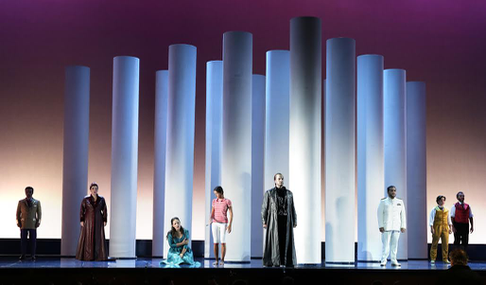 Principal Gazza ladra singers in ensemble scene, with magpie in center (in white shorts)
Principal Gazza ladra singers in ensemble scene, with magpie in center (in white shorts)
Whatever they might be (for Michieletto they are probably only white tubes) their geometrical arrangements on the stage were Michieletto’s idea of minimalism, as were the costumes, the heroine in a bright green dress the entire evening, the chorus women first in identical brilliant red dresses, then for the execution in identical taupe toned dresses as examples. The chorus was staged in geometric lines or blocks executing geometrically repetitive movements. Five storm troupers made a straight line tableau across the front of the stage displaying their Uzis horizontally over their heads for the execution of the simple peasant girl.
Michieletto is not a musical stage director, insisting that his adolescent magpie-girl intrude, clumsily choreographed, among the singers at the very moments it was possible that Rossini lyricism might take flight. La gazza ladra is mature Rossini, and that means that there is a big cast and abundant ensembles of magnificent musical architecture. This director is oblivious of these structures, placing his five, six or seven singers (and chorus) in arbitrary geometric patterns instead of allowing musical imperatives to determine how, when and where the components move. The famed crescendo of intensities of these fabulous ensembles were therefore intentionally thwarted.
The Rossini Festival has engaged Mr. Michieletto to stage a new La donna del lago for next summer. Go figure.
La gazza ladra is a semi-seria opera — a servant girl of a tenant farmer will marry the farmer’s son but not before it is determined who stole the silver spoon. Meanwhile the servant girl is assumed to have been the thief and has been condemned to death. It is absolute farce endowed with powerful emotional moments that require important musical involvement — its obvious dramaturgical and musical challenges are daunting.
The musical direction of this avowed Rossini masterpiece was entrusted to veteran conductor Donato Renzetti. Mo. Renzetti’s big Rossini period (in Pesaro and elsewhere) was in the early 1980’s. There has been much refinement in the musical understanding of Rossini in the last 30 years that has well surpassed the slow and heavy realization that this maestro imposes. It may well have comfortably accommodated the needs and expectations of the singers of previous generations but it does not support current musical practice. This was evidenced by repeated musical misunderstandings of the orchestra players and some of the singers, i.e. they felt and expected a celerity that was intentionally and forcefully squashed.
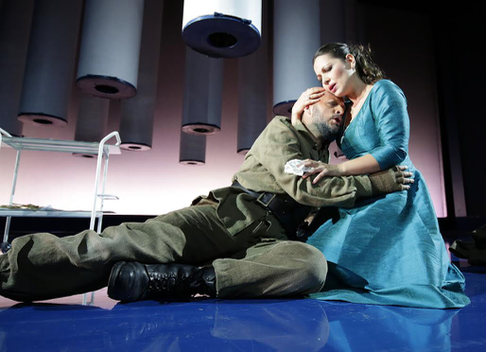 Alex Esposito as Fernando, Nino Machaidze as Ninetta
Alex Esposito as Fernando, Nino Machaidze as Ninetta
The role of the servant girl Ninetta was given to Georgian soprano Nino Machaidze. This artist, much beloved by Los Angeles audiences (Gounod’s Juliet as well as Traviata and Boheme) was the perfect, unrepentant Fiorella in L.A Opera’s production of Il turco in Italia, her hard-edged, brilliant coloratura dramatically convincing. Mme. Machaidze does not possess a sweet voice nor does she project a sweet personality that could embody the simple Ninetta. She is all diva business, and she does it very well, but these attributes do not make her a Rossini artist.
There was one fine Rossini artist in the cast, Alex Esposito who sang Ninetta’s father Fernando Villabella. This esteemed bass exudes character and executes thrilling coloratura. Pesaro audiences are famous for extended applause given well performed arias (or scenes). Mr. Esposito’s second act aria was the sole recipient of such appreciation for the entire four hour duration of the performance.
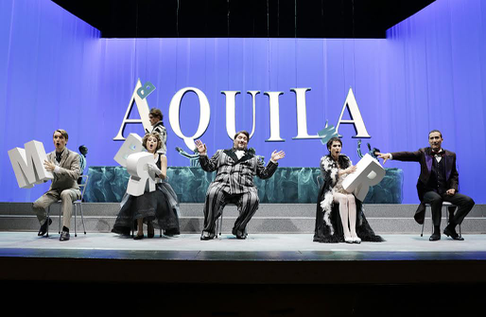 Principals singers of La gazzetta
Principals singers of La gazzetta
La gazzetta or in English The Newspaper was on stage at the 800 seat, horseshoe Teatro Rossini the second night (of the second cycle). This opera was a contractual obligation for Napoli’s Teatro dei Fiorentini (FYI it is now a bingo palace) where audiences loved to be entertained. Rossini lifted some of La gazzetta’s major pieces from his masterwork Il turco in Italia (1814), and composed fine new material as well that found its way a few months later into his masterwork La Cenerentola.
La gazzetta is not a masterwork. A simple enough story (albeit three pages of synopsis needed): a silly father places an ad in the Gazette of Paris offering his daughter in marriage. She however loves the innkeeper. It is a three hour mess that finally gets cleared up at a costume party. As the libretto is based on a play by famed 18th century playwright Carlo Goldoni there is a lot of lively repartee that leaves us non-Italians (there are a lot of us and we come from around the globe) at a disadvantage — plus the supertitles are way above the stage and in 18th century Italian.
None the less there was a lot to look at on the stage, too much, but the story was easy to follow. We just missed the Goldoni wit that we knew was there and way above us. Rossini is performance art, this piece dominated by an electric performance by dead ringer Rossini look-alike Nicola Alaimo (a Metropolitan Opera Falstaff as well as a famed Guillaume Tell) as Don Pomponio, the silly father.
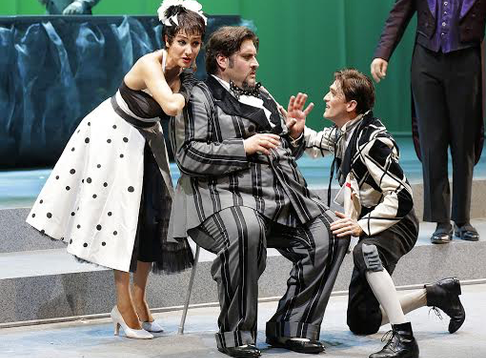 José Maria lo Monaco as Madama La Rose, Nicola Alaimo as Don Pomponio, Ernesto Lama as Tommasino
José Maria lo Monaco as Madama La Rose, Nicola Alaimo as Don Pomponio, Ernesto Lama as Tommasino
Stage director Marco Carniti gave Don Pomponio a side-kick servant mime he named Tommasino who seconded Don Pomponio’s decisions, argued with them, insisted that Don Pomponio’s wishes be carried out, and suffered Don Pomponio’s frustrations by repeated beatings. Neopolitan actor Ernesta Lama however was not a mute mime as he could not help himself from speaking out from time to time. It was pure comic delight. Stage director Carniti gave this physical theater performer much activity, and it was thoroughly musical, his physical intrusions into the arias and ensembles fully consistent with Rossini’s musical architecture (unlike the arbitrary Magpie intrusions in La gazza ladra).
Marco Carniti and his designer Manuela Gasperoni created a stage box fully enclosed by translucent plastic strips that easily absorbed projected colored light when not serving as a silhouette surface. Much of the mise en scène was in black and white, the costumes by Maria Filippi (a Franco Zeffirelli collaborator as well) were primarily in black and white but sometimes with bright color accents. This high design concept supported endless production numbers (like 1950’s American film musicals), including highly choreographed movement of the abstracted set pieces and much movement by four fine supernumeraries.
It was all too much for the simplistic wit of farce, and at the same time it was very well done and musically solid.
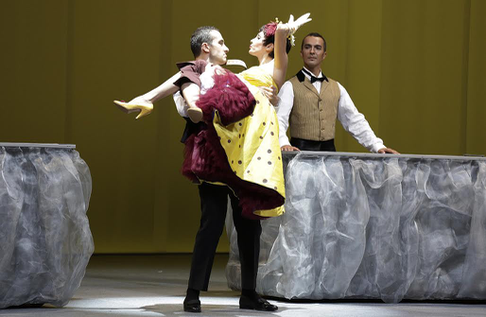 Hasmik Torosyan as Lisetta, Vito Priante as Filippo
Hasmik Torosyan as Lisetta, Vito Priante as Filippo
The singing was of good level, notably the silly father’s daughter Lisetta, sung by young Armenian soprano Hasmik Torosyan who last summer was a participant in the festival’s young artists program, the Accademia Rossiniana. The innkeeper Filippo was sung by Vito Priante who with Nicola Alaimo were the two fully accomplished performers of the evening, Mr. Priante offering delightful coloratura dressed as a Turkish suitor in the masquerade.
Conductor Enrique Mazzola provided an unobtrusive, fully idiomatic orchestral basis, but the wit and charm of Rossini’s orchestrations were overwhelmed by the production.
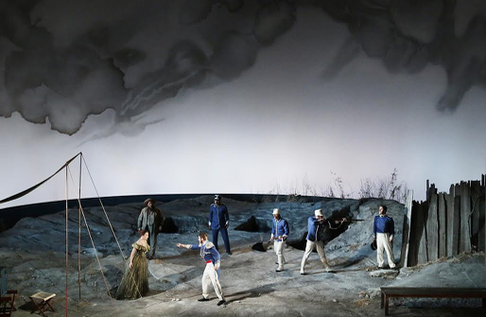 Principal singers of L'inganno felice
Principal singers of L'inganno felice
A Graham Vick production is always news, even moreso because this L’inganno felice was the revival of his 1994 Pesaro production for the Teatro Rossini, staged before he had become one of the world’s most admired and adventurous stage directors. In recent years he has reappeared at Pesaro with Mosé in Egitto (2011) and Guillaume Tell (2013) — both mise en scènes are masterpieces.
L’inganno felice is a simple, sentimental farce, the oft-used situation of a foundling baby, but here beautiful young woman, having been washed up on a shore. Here the shore was near a remote mine somewhere. A kindly old miner protects her and engineers a safe return to her beloved husband by tricking the very evil suitor she had rejected.
Vick and his designer Richard Hudson (most famous for The Lion King [1988], but on the other hand famous for this winter's Graham Vick production of Götterdämmerung at Palermo’s Teatro Massimo) imagined one grand diminution of light over the one and one half hours of the opera’s only act. The production’s original lighting designer Matthew Richardson returned to once again effect this spectacular light show — high noon becomes late afternoon then early evening, finally night falls to give cover for the deception. Meanwhile a miniature steamship traverses the far away, endless horizon for the duration of the action.
The set is an enormous curved white cyclorama with some Japanese looking gray splotches as clouds. There was a hole for the mine, a bench on the right indicating a house just offstage. When Nisa’s long lost husband, Bertrando happens to happen by he erects a tent on the other side of the stage. The stage floor is in cinematic detail, a realistic slope complete with struggling shrubs.
However Bertrando and his soldiers are straight out of nineteenth century operetta, Bertrando with grandiose epaulettes. Greek tenor Vassilis Kavayas, a recent Rossini Academician, brought ultimate snap and sparkle to his character as did his snappy soldiers to their marching entrances and exits.
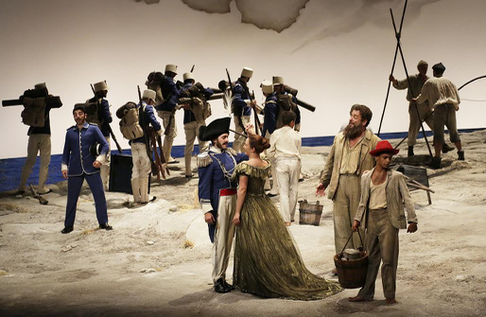 Giulio Mastrototaro as Ormondo (blue uniform), Vassilis Kavayas as Bertrando, Mariangela Sicilia as Isabella, Carlo Lepore as Tarabotto, plus soldiers and supernumeraries
Giulio Mastrototaro as Ormondo (blue uniform), Vassilis Kavayas as Bertrando, Mariangela Sicilia as Isabella, Carlo Lepore as Tarabotto, plus soldiers and supernumeraries
The realistically costumed rustic miner Tarabotto was sung by veteran basso-buffo Carlo Lepore whose accomplished presence anchored the young cast. Also simply costumed in rags was Nisa, sung by ingenue soprano Mariangela Sicilia, a recent Rossini Academician as well. She began the evening with a splendidly sung contemplation of a tiny necklace pendent portrait of her long lost husband. Most of her remaining music required sustained singing but as the evening progressed her intonation seriously deteriorated.
Young Italian baritone Davide Luciano brought seriously snappy buffo to his role, Batone, an ardent, if not too bright sergeant. He had much to sing, and did a convincing and charmingly energetic performance that made you wish his coloratura was just a bit sharper. As it was the high point of the evening was the extended duet Batone sings with the miner Tarabotto where Tarabotto induces him into the deception. This duet and Alex Esposito’s aria “Eterni Dei, che sento!” in La gazza ladra were the two high points of all three operas of the festival)
With his eclectic set and his spotty cast Graham Vick’s palate had a bit of everything to work with. It was all masterfully laid out in low key, absolutely unpretentious terms, allowing us to enjoy all these wonderful performances without critical prejudice — though may we believe that back in 1994 perhaps the Vick production had considerable artistic prétention.
Great Rossini begins in the pit. The conductor was a thirty-four year old Russian, Denis Vlasenko, still another of the evening’s former Rossini Academicians. While Pesaro’s Orchestra Sinfonica G. Rossini lacks the finesse of the Orchestra del Teatro Comunale di Bologna (in the pit for La gazza ladra and La gazzetta) this young maestro still was able to create an estimable Rossini elation from time to time, the Rossini high that brings us back to Pesaro year after year.
Michael Milenski
Cast and production information
La gazza ladra: Vingradito: Simone Alberghini; Lucia: Teresa Iervolino; Giannetto: René Barbera; Ninetta: Nino Machaidze; Fernando Villabella: Alex Esposito; Gottardo: Marko Mimica; Pippo: Lena Belkina; Isacco: Matteo Macchioni; Antonio: Alessandro Luciano; Giorgio: Riccardo Fioratti; Ernesto/Il Pretore: Claudio Levantino; Una Gazza (mute): Sandhya Nagaraja. Orchestra e Coro del Teatro Comunale di Bologna. Conductor: Donato Renzetti; Stage director: Damiano Michieletto; Scenery: Paolo Fantin; Costumes: Carla Teti; Lighting: Alessandro Carletti. Adriatic Arena, Pesaro, Italy, August 13, 2015.
La gazzetta: Don Pomponio Storione: Nicola Alaimo; Lisetta: Hasmik Torosyan; Filippo: Vito Priante; Doralice: Raffaella Lupinacci; Anselmo: Dario Shikhmiri; Alberto: Maxim Mironov; Madama La Rose: Josè Maria Lo Monaco; Monsù Traversen: Andrea Vincenzo Bonsignore; Tommasino (mute): Ernesto Lama. Orchestra e Coro del Teatro Comunale di Bologna. Conductor: Enrique Mazzola; Stage director: Marco Carniti; Scenery: Manuela Gasperoni; Costumes: Maria Filippi; Lighting: Fabio Rossi. Teatro Rossini, Pesaro, Italy, August 14, 2015.
L’ingannno felice: Mariangela Sicilia; Bertrando: Vassilis Kavayas; Ormondo: Giulio Mastrototaro; Tarabotto: Carlo Lepore; Batone: Davide Luciano. Orchestra Sinfonica G. Rossini. Conductor: Denis Vlasenko; Stage director: Graham Vick; Scenery and Costumes: Richard Hudson. Lighting: Matthew Richardson. Teatro Rossini, Pesaro, Italy, August 15, 2015.
image=http://www.operatoday.com/Gazza_Pesaro1.png
product=yes
product_title=Rossini Opera Festival, 2015
product_by=A review by Michael Milenski
product_id=Above: Sandhya Nagaraja as the magpie, Teresa Herovlino as Lucia in La gazza Ladra
All photos copyright Studio Amati Bacciardi, courtesy of the Rossini Opera Festival.
August 19, 2015
Santa Fe: Placid Princess of Judea
That is not to say there were not some excellent components in the mix, but the pervasive uneasiness that must underpin any good production of this shocking masterpiece, was in short supply.
Let us start with concept that placed the piece at the turn of the last century. Director Daniel Slater attempted to infuse the work with layers of Freudian introspection so contemporary at that time. There is merit in this to be sure. But I found the result was too often a stand and sing affair that bordered on costumed concert opera.
Mr. Slater was not helped by Leslie Travers’ straight-jacketing formal evening wear and colorful military uniforms, gorgeously executed as they were. Nor was Travers’ giant rotating set very atmospheric or evocative. The "cistern" was relegated to a pit in front of a monolithic cement-block box that had windows and doors aplenty which could reveal different scenarios as the whole shebang spun effortlessly.
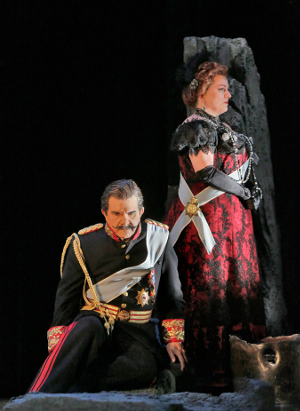 Robert Brubaker as Herod and Michaela Martens as Herodias
Robert Brubaker as Herod and Michaela Martens as Herodias
For example, Jochanaan was revealed, not in the cistern, but in a crumbling study, where he is frantically scribbling exhortations, resembling Rasputin as a barefoot student ascetic. The opening party referred to by Narraboth, usually offstage, was revealed up and center, looking like a very proper “Downton Abbey” dinner party. Rick Fisher’s lighting design provided all that was required with good area definition and nice gobo effects. The turbulent moon effects, so carefully scripted, were completely absent.
For Salome’s critical dance, the large vertical window opened to create a stage of sorts. As Salome did graceful (if unimaginative) arm gestures, a back wall crept forward to enclose the box, while cockeyed windows revealed Salome as a young girl who witnesses Herod killing her father, who had been imprisoned in the very same cistern that holds Jochanaan. Or that “would” hold Jochanaan, except that we are not using the cistern, but rather the library. Confused?
I only know the above dance scenario to be true since I read the director’s notes. My friend, who hadn’t and who was attending his first ”Salome,” did not understand what was going on.
Salome herself, clad in a chaste blue gown for most of the night, seems more a petulant debutante than the troubled, perhaps sexually abused adolescent. As Salome rather tamely comes on to Jochanaan, Narraboth, in military uniform and sash stands stoically down right, staring out front.
Eventually he starts to get turned on by the trash-talking heroine and slowly, subtly begins undoing clothing and feigning looks of sexual arousal, even removing, crumpling and sniffing his white sash. He never actually looks at the action and when he finally stabs himself, he is looking front.
Director Slater clearly intended this full frontal connection and it is a visual theme. The quarrelsome Jews only occasionally sing to each other, mostly just changing places in a straight line to sing to us. And once they sing, they leave. In fact, everyone does that.
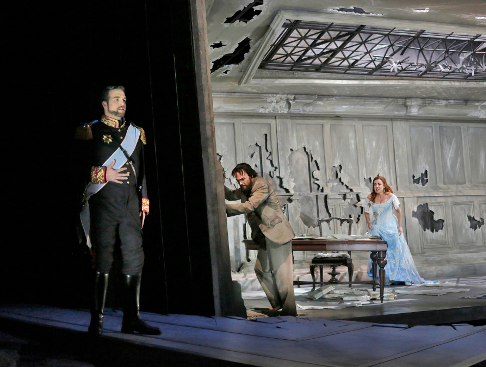 Brian Jagde as Narraboth, Ryan McKinny as Jochanaan, and Alex Penda as Salome
Brian Jagde as Narraboth, Ryan McKinny as Jochanaan, and Alex Penda as Salome
In the last third of the show, Herod and Herodias, alone, gape at the auditorium expressionless through most of the dance and through all of the brutal final scene. If this is supposed to evoke Freudian preoccupation, it was about as exciting as watching a patient lie on a sofa for an hour.
Herod removed his own ring and hurled it off right. This makes hash not only of his asking “Who has taken my ring?” but also of its importance as a royal signal to the Executioner to behead the Baptist. Never you mind because there is no Executioner. Oops. So who killed Jochanaan? I guess Freud did it. . .
Happily, the music-making offered much compensation. David Robertson conducted with a knowing hand, and the sublime orchestra rose to meet every Straussian challenge. The exposed solo work was full of personality, and the cello and contra-bassoon effects were especially affecting. If the Maestro got off to a more deliberate start than other readings I have heard, perhaps it was owing to the distraction of a smattering of entrance applause just as he gave the downbeat. It seems that the production wanted to sneak him on to the podium unremarked, but it is something to reconsider if can precipitate this kind of false start.
For most of the 100-minutes, Robertson and his band struck an admirable balance with the stage. It is not the Maestro’s fault if the evening’s Salome is about one and half vocal sizes too small for the role.
Alex Penda is a lovely artist, exceedingly musical, and she commands a silvery soprano that, when unleashed at forte in the upper register is downright thrilling. Her chest voice has bite and presence. And then . . .there is that pesky lower middle where many phrases, and more to the point, phrase endings, lie.
Ms. Penda’s is essentially a heavy lyric instrument, and to make it speak in mid-range against some dense instrumentation, she pushes it within-but-to her limits. The result is occasional inaudibility, a Sprechstimme that veers off the pitch, or a nasal, childish retort. Salome is a big, big sing and Alex mostly succeeds admirably to conquer the role on her own terms. It should be reported that the audience rewarded her with a generous ovation.
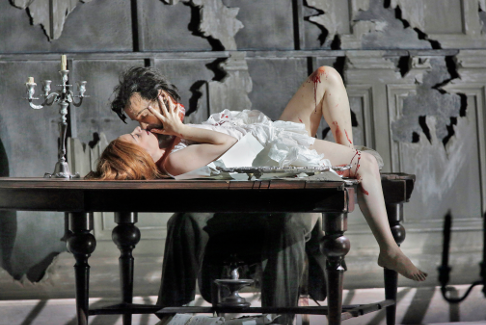 Alex Penda as Salome
Alex Penda as Salome
She is certainly the right physical type and another production might have capitalized more on her considerable dramatic range. In the final scene, when she was finally unleashed as a prowling cat savoring its victim, she had superb presence. But where was that character specificity the rest of the night? I applaud Alex Penda’s commitment and resourcefulness, but maybe she should let the next Salome incubate a few years.
Ryan McKinny has all the goods for a first tier Jochanaan, namely a meaty, forceful bass-baritone that has powerful point and burnished quality in every register and volume. Mr. McKinny found all the heft necessary for the big statements, and other times sang with sensitivity, understanding, and ever-present beauty of tone. It is a pity that the costume design had him all buttoned down as he is an attractive man, yet there was no opportunity to display the primal physical appeal that fuels Salome’s carnal instincts. Still, Ryan brought an oversize presence to the role and true star power to the evening.
Brian Jagde was luxury casting as Narraboth, a role that could easily have been assigned to one of SFO’s excellent young artists. Mr. Jagde has been singing Puccini heroes of late, and he brought that same full-throated vocal approach to the young Syrian soldier. He negotiates the dramatic outbursts with effusive tone, and he affects an appealing lyricism that underlies the Syrian soldier’s fatal boyish infatuation with the princess.
I have long admired Robert Brubaker’s heroic tenor and his rock solid technique. I wish I could report that the quirky, high-lying Herod was a good fit for this intelligent singer. On this occasion, I wondered if he might have been indisposed (there was a bit smoke in the air after all). Although no announcement was made, he coughed a couple of times and seemed to clear his throat.
Although the usual polished bronze tone was most often securely deployed, some held high tones were negotiated through sheer will. Herod is a tricky part with much angular singing, and leaps to sudden high outbursts. Mr. Brubaker also seemed hamstrung by the patrician, effete characterization that replaced the more unrestrained immoral despot.
As his paramour, Michaela Martens was an imposing Herodias. More dowager empress than aging adultress, Ms. Maertens nonetheless sang with a searing, ripe mezzo that rode the orchestra with ease. Her acerbic protestations had zing and dramatic import. Curious that at opera’s end, her Herodias was made to cross to the extra library chair, remove her jewels and wrap, and embrace Jochanaan’s pre-set jacket. All is forgiven?
Megan Marion sang most appealingly as the Page, Nicholas Brownlee showed great promise as the First Soldier, and Tyler Putnam sang with knowing power as the Second Soldier. The bickering Jews had a freshness and appeal, all of them being taken by Young Artists. Singing with accuracy and fire all five reflected great credit on the apprentice program: Christopher Trapani, Roy Hage, Cullen Gandy, Aaron Short, and Kevin Thompson. Not to be outdone, colleagues Peixin Chen and Adrian Kramer shone as the First and Second Nazarenes, respectively.
Salome was the first opera I ever saw at Santa Fe Opera, back in the day with no less than Josephine Barstow supported by John Crosby in the pit. There have been a lot of productions of it in between for me in places ranging from New York to Paris to Stuttgart. If this current, well-intended mounting had its shortcomings, its many strengths served to reinforce the enduring power of Strauss’s creation, and rekindle a lifetime of Salome memories.
James Sohre
Cast and production information:
Narraboth: Brian Jagde; Page: Megan Marino; First Soldier: Nicholas Brownlee; Second Soldier: Tyler Putnam; Jochanaan: Ryan McKinney; Cappadocian: Peter Tomaszewski; Salome: Alex Penda; Butler: David Bates; Herod: Robert Brubaker; Herodias: Michaela Martens; First Jew: Christopher Trapani; Second Jew: Roy Hage; Third Jew: Cullen Gandy; Fourth Jew: Aaron Short; Fifth Jew: Kevin Thompson; First Nazarene: Peixin Chen; Second Nazarene: Adrian Kramer; Conductor: David Robertson; Director: Daniel Slater; Set and Costume Design: Leslie Travers; Lighting Design: Rick Fisher; Choreographer: Sean Curran; Fight Director: Rick Sorde
image=http://www.operatoday.com/6%20Alex%20Penda%20%28Salome%29%20and%20Ryan%20McKinny%20%28Jochanaan%29%20in%20%E2%80%98Salome.%E2%80%99%20Photo%20%C2%A9%20Ken%20Howard%20for%20Santa%20Fe%20Opera%2C%202015.png
image_description=Alex Penda as Salome and Ryan McKinny as Jochanaan [Photo by Ken Howard]
product=yes
product_title=Santa Fe: Placid Princess of Judea
product_by=A review by James Sohre
product_id=Above: Alex Penda as Salome and Ryan McKinny as Jochanaan
Photos by Ken Howard
August 12, 2015
Airy and Bucolic Glimmerglass Flute
Director Madeline Sayet (a member of the Monhegan tribe) and her design team have fashioned a concept that centers on a Tree of Life imagery that has roots in both Native American and Judeo-Christian tradition.
Gone are the mysterious, pervasive tenets of Freemasonry, here replaced by an engaging coming of age story. In the second half of the overture, Tamino is revealed behind a scrim as a burnt out businessman, uptight and unhappy in his straight jacket of a business suit, assaulted by urban bustle and impersonal jostling. His soul impetuously leads him to the natural healing promise of unspoiled nature.
Troy Hourie has created a forest environment that is at once soothing and permeated by a mystic energy. Good vibe? Bad karma? Who knows? The slightly stylized trees subtly suggest primitive imagery. The imposing tree structure just left of center, reveals an upper “window” not unlike the apparition of Cinderella’s Mother in Into the Woods. The Speaker is first revealed here for his pivotal encounter with Tamino.
All of the set pieces are crafted of natural materials. At rise, a large sculpted structure of woven branches stage right simultaneously creates a bridge, a ramp and a tunnel. Director Sayet utilizes the environment with insight and imagination.
Eight woodland nymphs (dancers) are never far away and they imbue the tale with a ritualistic feel that embodies the story’s spirituality. The monster that chases Tamino consists of that dance team brandishing menacing tentacles of bare branches. That intimidation of the hero is a direct parallel of his having just been overwhelmed by urban life.
The lithe spirits are a terrific addition to the trials. As the group flails branches with fan-shaped white cloths attached to the ends, lighting designer Mark McCullough illuminates the action so that effect can flicker like flames, or roll and pitch like waves of water. As Mr. Hourie’s bowers of designer trees tracked to new positions, and Mr. McCullough cross-faded the lighting effects and adjusted the gobos and filters, the visual elements pulsed and glowed.
Costumer Kaye Voyce let her imagination run loose and she has contributed designs that are a heady mix of contemporary realism, and a Woodstock woodland fantasy. The horny three ladies are in free love, tie-dyed get ups. The Queen is an icily cool she-bitch that is the antithesis of her flighty attendants. Sarastro seems to be a white-coated environmentalist, accompanied by four “Priests” who have matching coats, phosphorescent green dickies, and appear to be kindred ecologists. Papageno is a hunter, in orange safety tunic, cammo vest and pants. Have you gotten the idea yet that there were some very detailed concepts at play here?
The director has effectively conspired with English language adapter Kelly Rourke who has not so much translated from the German as cunningly captured the essence of its soul and re-imagined it to good effect. I usually hate this juggling around and tampering, but I have to say that this duo has absolutely maintained the arc of the story, the intent of the journeys, the heart of the characters, and the glory of the musical vocabulary. It resonates. It touches. It repurposes a somewhat jumbled mix of ideas and focuses them beautifully in a focused concept.
Monastatos for once seems truly threatening. As he and his retinue skulk around the woods in hunter garb, there is an ominous, Deliverance-like menace to their scenes. If Cousin Itt and Sasquatch had had a Love Child, it would not look unlike Papagena when she first appears in a consuming, enveloping furry pelt. The chorus, tucked high up in the house balcony is invisible. Mysterious.
Not everything lands absolutely. When rather normal looking Papageno laments being unlucky in love because he is “different,” well honestly, any number of the Ladies of WalMart would snap this hunter right up. The ladies do not punish Papageno’s lies with an actual lock in his mouth and that surefire bit goes for little. And the flute itself was a puzzle. Tamino seems to be playing it like Kenny G blowing a soprano sax. I guess it really was magic!
The festival has assembled a first rate cast who threw themselves wholeheartedly into this engaging rendition, all the while singing with heart, stylistic acumen, and good humor.
I very much enjoyed Sean Panikkar as Tamino in last year’s St. Louis Flute and he has only gotten even better since. The handsome tenor possesses a bright, ringing, appealing lyricism that is a perfect fit for the role. Once in awhile, Mr. Pannikar seems intent to nail a note rather than just sing it, but he never loses his tonal beauty.
Jacqueline Echols was a near perfect Pamina. She commands an ideal Mozartean instrument, warm, somewhat instrumental, and completely at her service. If her character was at first a bit too hip and casual, Ms. Echols warmed to the journey and discovered a noble bearing. She was deprived of some gravity when her scripted set-up to Ach, ich fuehl’s was: Why won’t anyone talk to me? That is not at all the same import as the original: This is worse than death.
Ben Edquist found his footing as Papageno after a rather detached entrance aria. As the story evolved Mr. Edquist found a winsome charm and vocal confidence. I would urge him to bring the immediate conversational appeal of his singing in Act II forward to include the start of Act I. Jasmine Habersham was a perfect foil as his Papagena, her infectious high spirits and well-projected soprano were chockfull of fun and spunk.
So Young Park’s incisive, firebrand of a Queen of the Night was arguably the audience hit of the day. Her penetrating lyric tone was deployed fearlessly with staggering accuracy. Her fearless attacks were supremely controlled, sustained tones were full-bodied, and her fleet coloratura was nigh unto flawless.
The gifted young bass Soloman Howard, who was such a stirring Banquo in Macbeth, found Sarastro a substantially different sing. To be sure, Mr. Howard’s dark, imposing bass was capable of even lines and solid presence. But there is a serenity and inevitability in great interpreters of this part that are just beyond his current artistic reach.
Nicholas Nestorak revealed himself to be a wonderful singing actor as Monastatos. He invested his text with nefarious import and his lean tenor rode above the orchestra. Rhys Lloyd Talbot intoned the Speaker’s pronouncements with an appealing, measure baritone. Stephen Carroll and Anthony Schneider sang sturdily with inexorable forward motion as the Armored Men.
Raquel González, Aleksandra Romano, and Claudia Chapa were beautifully matched as the First, Second and Third Ladies, respectively. Their warm, appealing voices and excellent diction blended well yet each displayed an individual vocal and dramatic personality.
Joelle Lachance, Samuel Solomon, and Andrew Pulver were the scene-stealing Three Spirits. These three lads were beautifully trained, blended well, and were superbly focused, although in lower range they were occasionally covered by the orchestra.
Carolyn Kuan conducted with a clean delicacy. The requisite fire was summoned in aggressive passages, and there was loving attention to detail throughout. The orchestra responded with a warm, dramatically assured reading. I only wished that Maestra Kuan might discover a little more breadth and variety of pace in the critical exchange between Tamino and the Speaker. There are some important discoveries and revelations that seemed to press ahead rather than unfold.
James Sohre
Cast and production information:
Tamino: Sean Panikkar; First Lady: Raquel González; Second Lady: Aleksandra Romano; Third Lady: Claudia Chapa; Papageno: Ben Edquist; Queen of the Night: So Young Park; Monastatos: Nicholas Nestorak; Pamina: Jacqueline Echols; Speaker/Second Priest: Rhys Lloyd Talbot; Sarastro: Soloman Howard; First Priest: Brian Wallin; Papagena: Jasmine Habersham; First Armored Man: Stephen Carroll; Second Armored Man: Anthony Schneider; First Spirit: Joelle Lachance; Second Spirit: Samuel Solomon; Third Spirit: Andrew Pulver; Conductor: Carolyn Kuan; Director: Madeline Sayet; Translation: Kelley Rourke; Choreographer: Eric Sean Fogel; Set Design: Troy Hourie; Costume Design: Kaye Voyce; Lighting Design: Mark McCullough; Hair and Make-up Design: Anne Ford-Coates.
Glimmerglass Conquers Cato
The title was somewhat a cheeky selection, containing as it does the name of a nearby New York town. However, once that in-joke is acknowledged, the work justifies its festival position by bringing to the stage Metastasio's poetic depiction of Cato the Younger as quite brilliantly musicalized by Antonio Vivaldi.
The first act score has never been found, so revivals have compensating choices to make as to reconstruction. Alessandro Ciccolini devised one such completion and composed some music for missing passages using Vivaldi concerto themes as inspiration. The finale was wholly instrumental, and worthy of Vivaldi’s intentions. Since much of Vivaldi’s output has been forgotten (or missing), this American premiere was a welcome opportunity to experience a drama that deserves to be performed.
Conductor Ryan Brown coaxed an edgy, rhythmically incisive reading from his accomplished players, whose dramatic commitment made them true collaborators in underpinning the vocalists’ emotional state. The vast majority of the da capo arias range from brisk to brisker and the Maestro showed an unerring hand in accommodating the soloists. When the mood and tempo did relax, Brown let the players luxuriate in meaningful solo flights and he evoked moody atmospheres. The continuo work was meticulous, especially the inventive theorbo work by Michael Leopold.
If there was one breakout, star-making performance in the Festival, it would be the dynamic portrayal of Caesar by counter-tenor John Holiday. As he launched into his first aria you could sense the excitement build in the audience as palpable electricity was generated between stage and audience. We sat up and leaned forward to relish his every melisma, his fierce commitment, his flawless technique and his highly personal, gleaming tone.
It is often difficult for this voice category to offer much variety because of the tonal production demands. But Mr. Holiday’s Caesar-in-love had a very different color and delivery than Caesar-at-war. His ascending war hoops (sort of Vivaldian ho-jo-to-ho’s) were chilling in their vicious impact. The passagework was faultless and always rooted in the drama. It just doesn’t get better than this. The intermission and post-show buzz confirmed that a star was born.
This is not to take anything away from the evening’s other counter-tenor. Young Artist Eric Jurenas offered a completely different sound as Arbace, tightly focused in its delivery of secure, highly musical contributions. He was believable as the sexed up aggressor, and became sympathetic after his romantic rejection.
As Cato’s daughter Marzia, Megan Samarin (another accomplished Young Artist) sports an appealing, warm mezzo, with a slight cover to the delivery. Ms. Samarin commendably throws herself into the drama, but when emoting overtakes her concentration on technique or when she pushes the final syllable of phrases for effect, she can veer slightly off pitch.
Allegra De Vita served the role of Fulvio well, with a gleaming mezzo of great presence and security. Ms. De Vita exuded lots of personality and she had a handsome stage presence. This was the sort of assured performance from a Young Artist that foretells even greater things.
Sarah Mesko’s astonishing range and trip hammer agility on display in Bad-Girl-Emilia’s two murderously difficult arias produced some awesome effects. She pulls a few tricks when she negotiates top notes in rapid runs or at phrase ends by darkening and slightly pulling back. But hey, whatever it takes. This is fiendishly challenging writing. All other times, the even tone is throbbing, glistening, and exciting.
Thomas Michael Allen brought a regal bearing and conscientious commitment to Cato. But his title character did not have the distinctive timbre or emotional investment of his remarkable cast mates. His slender tenor was somewhat dry and, while it found some fire late in the evening, it lacked weight.
The design team has come up with a handsome, inventive, smoothly flowing production.
John Conklin’s gilt, tawny set design featured ancient ruins and conveyed august dignity. A giant arch upstage center reveals stylized projections of a column, or collosseum, or obelisk, or a serene moonlit desert. The fallen pillars and altarpieces that litter stage left and right are richly painted in passionate reds, oranges, rusts, and golds. A Rothko-like red square makes an appearance at the opera’s beginning, and is a recurring symbol that gets flown in at various junctures, in various sizes, and on various fly lines.
This monolithic appearance could suggest a bloody order. Or maybe a bloody wall? Boxed in violent emotions? All I know is it was handsome, nicely textured, and it engaged us by allowing us to “speculate.” The first three acts (played together) are in this handsome unit set. After intermission, act four found the ancient ruins removed, effectively suggesting a clear, open battlefield for Cato and Caesar’s final confrontation. Robert Wierzel’s evocative lighting really came into its glory here as a giant pallid square flew in isolating Emilia front and center, only to turn blood red, trapping the character downstage for her hysterical, stuttering climactic showpiece.
Costume designer Sara Jean Tosetti proves herself a critical partner in identifying the characters with wildly inventive and colorful riffs on traditional period dress. Marzia’s first diaphanous yellow gown is used brilliantly to convey her girlishness, and also her recklessness in loving Caesar. Emilia’s dangerous purple, hooded gown has an ostentatious train and quirky accents. Caesar’s regal blue sums up his stature and his power. Arbace’s vest with its hippie fringe was an apt visual representation of the randy lad.
Wig and Make-up designer Anne Ford-Coates has contributed her usual high quality work the whole season but nowhere more effectively than here. The personalized look for each character was a successful fusion of ancient tradition and contemporary coiffures. Only the bald Cato escaped her magic touch.
Director Tazewell Thompson started the evening with a master stroke as the characters walked one by one into a spot light behind a scrim, upon which was projected their character name and their relationship to the story. Instant understanding! After this effective orientation, Mr. Thompson created beautiful movement, inspired by the dramatic moment, and springing from truthful relationships.
The director had actors use the ruined columns and plinths in all manner of traffic patterns by sitting, reclining, standing upon, circling around, and climbing up and down. The instrumental introductions, interludes and closing bars of arias were anything but clichéd pacing visualizations. Tazewell invested them with meaningful motion: a playful, child-like game between Arbace and Marzia; an emotion-filled volcanic eruption for Caesar; a cat-like tension for Emilia; a wilting supplication for Marzia; a controlled movement for Cato that explodes into a physically abusive treatment of his daughter. This was an informed, meaningful dramatic realization of the piece.
The best staging moment was arguably the last. Reverting to Vivaldi’s original intent of having Cato commit suicide, a final revelation showed the lifeless Cato splayed in his chair, back to the audience, arms spread, wrists bled dry (thanks to attached red cloths). The rest of the players solemnly paid obeisance to him in character until they evolved into a final tableau as the orchestra exquisitely played an interpolated dirge.
This was a memorable evening laden with marvelous music and emotional import. Utica. It’s worth the trip.
James Sohre
Cast and production information:
Cato: Thomas Michael Allen; Marzia: Megan Samarin; Fulvio: Allegra De Vita; Arbace: Eric Jurenas; Emilia: Sarah Mesko; Caesar: John Holiday; Conductor: Ran Brown; Director: Tazewell Thompson; Choreographer: Anthony Salatino; Set Design: John Conklin; Costume Design: Sara Jean Tosetti; Lighting Design: Robert Wierzel; Hair and Make-up Design: Anne Ford-Coates.
Energetic Glimmerglass Candide
Having famously flopped in its 1956 Broadway debut, partly owing to its sprawling Voltairean ambitions and dark Lillian Hellman book, its score was nevertheless widely admired. It wasn’t until 1973 that Harold Prince had the vision to scale back the focus, infuse the tale with sassiness and punch, and set the revamped version in a circus-like environment with the action exploding in, around, and through the audience.
Capturing on the (then) quadrophonic sound craze, the orchestra was split into four components. Broadway had never seen anything quite like it. The taut, intermissionless version convinced audiences that Candide was now viable, accessible, and it became one of the solid hits of the season. I saw it and loved it three times.
And then the tinkering and re-imagining began, at opera houses and theatres worldwide, until the show has regained somewhat a meandering grab-bag approach that strains the concentration. I had never seen an expanded Candide such as this Royal National Theatre Version used by Glimmerglass.
Director Francesca Zambello has wisely chosen to stage it as a Broadway show, and she has invested the proceedings with all her trademark invention and pacing. Ms. Zambello has an excellent team of Young Artists at her disposal and she shows off the depth of the roster with skill and affection.
Francesa filled the stage with enough good ideas for about 10 shows, and all of them were welcome. She set the tone brilliantly during the second half of the overture, with a clown car effect in which a theatrical trunk was placed center stage and performers kept climbing out of it, as dust covers were removed from other set pieces revealing half clad actors who scamper up stairs, and clamber onto ladders to make a final pose at the close of the famous overture. What a witty, Cirque de So Gay start to the night!
Thereafter, the director and design team did their damnedest to keep the stage filled with motion, effects, dances, and most of all, a semblance of clarity. All in all, they served this version well. James Noone’s massive, versatile set design was a theatrical backstage structure that kept morphing into one locale after another. In this accomplishment, Mr. Noone was ably abetted by Mark McCullough, whose fluid lighting design was characterized by effective split second timing. Mood and location changes were well reflected in the color filters and gobos.
Jennifer Moeller’s eye-popping costumes ran the gamut from military uniforms to showgirls to be-jeweled red sheep to courtesans to soldiers to clerics to . . . hmm. . .the kitchen sink must have been in there somewhere. Ms. Moeller clearly relished her assignment and, to our delight, she had a field day.
Choreographer Eric Sean Fogel brought real Broadway flair to production numbers that were ebullient and well-shaped. He made much more of I Am Easily Assimilated and Eldorado than I imagined possible. The latter with its Las Vegas sensibilities would not be out of place in Sin City’s Jubilee.
In Amadeus, Emperor Joseph II critiques Mozart’s music as “too many notes.” On this occasion, I felt Candide had “too many words.” You couldn’t always tell the players without a program, and so Dr. Pangloss (oh, excuse me: Voltaire) keeps nattering on and on just to try to keep us up to snuff on who the hell is who, where the hell they are, and why the hell we care.
This is to take nothing away from the excellent David Garrison in those dual roles. He is a Broadway pro and it shows. He commands our interest, sings in a pleasing baritone, and enters into the fun with abandon. Mr. Garrison held the show together, keeping the narrative going through paragraphs and paragraphs (did mention paragraphs?) of explanations. When he speeds and slurs through one final ludicrous scenario of a speech near show’s end, the audience erupts into applause for his having dispatched yet another long windy moment with witty bravado.
Andrew Stenson has diminutive, wide-eyed, boyish good looks that made for a generally appealing Candide. He has a nice technique, but the tone could have benefitted from a bit more brilliance. Mr. Stenson entertained us without moving us. He came closest to connecting specifically with the material in Nothing More Than This, before he isolates himself from the others. But when he relents and returns for the denouement, he reverts to his earlier generalized presentation.
Kathryn Lewek sang marvelously as Cunegonde with a pointed, silvery soprano that was highly accurate and pliable. She and her director have definite ideas about the role that changed the balance of the show for me. Here, the heroine has been stripped of her sweetness and naivete. Her impeccably voiced Glitter and Be Gay was played as a Mad Scene. Instead of gleefully and girlishly piling on the jewels, this Cunegonde hysterically hurls them away. I respect the choice and the consistency, but it did make for a cool relationship with Candide.
Christian Bowers’ sturdy Maximilian was well served by a pleasant baritone that could benefit from a bit more forward placement. His slightly covered top was challenged by the strings of octaves in Life is Happiness Indeed. As Paquette, Kristen Choi had a spunky sex appeal, and she showed off a well-schooled, appealingly smoky mezzo.
Veteran Marietta Simpson didn’t miss a trick as the Old Lady with her spot-on comic timing and hilarious Mittel-European accent of undetermined origin. Ms. Simpson has an noticeable register break in her mezzo, but she certainly knew how to use her voice and maximized her resources as she scored all the character’s points.
Brad Raymond brought very solid singing and infectious spontaneity to his doubling as the Governor and Grand Inquisitor. The gender bending in the casting assignments was all in good fun, and Cynthia Cook’s turn as the villainous ship captain Vanderdendur was a delightful quirk. Although I found the version’s inclusion of two characters extraneous and muddying, there is no denying that Andrew Maughan brought a fine voice and good presence to Cacambo, and Matthew Scollin excelled as the pessimistic Martin with spot-on vocalizing.
Thanks to Francesca Zambello, this was a hard-working, finely tuned ensemble, absolutely focused and tightly knit. The entire group is often called upon to turn on a dime and become wholly different characters. And they do. Favorite moment: the ensemble is littered as corpses on a battlefield, and when the narration says that Candide soon arrives at another battlefield, the group of corpses flops over as one to “change locale.” (Talk about turning on a dime. . .)
Under Joseph Colaneri’s baton, the orchestra played securely, but perhaps a bit more cheekiness could have been summoned. The overture was correct and clean but lacked that final bit of insouciance. Bon Voyage could have had a headier lilt. The underscoring that contributed so much to the pace and continuity of the 70’s revival has sadly been all but removed. All the beloved set pieces are in their place to be sure, but it has to be said that some rather indifferent Bernstein has also snuck into the score.
Still, if you are going to embrace this edition, then this was likely the best of all possible Candide’s.
James Sohre
Cast and production information:
Cunegonde: Kathryn Lewek; Old Lady: Marietta Simpson; Candide: Andrew Stenson; Baroness/Vanderdendur: Cynthia Cook; Maximilian: Christian Bowers; Martin/James: Matthew Scollin; Pangloss/Voltaire: David Garrison; Paquette: Kristen Choi; Cacambo: Andrew Maughan; Grand Inquisitor/Governor: Brad Raymond; Baron: Marco Cammarota; Inquisitors: Brian Vu, Anthony Schneider; Conductor: Joseph Colaneri; Director: Francesca Zambello; Choreographer: Eric Sean Fogel; Set Design: James Noone; Costume Design: Jennifer Moeller; Lighting Design: Mark McCullough: Hair and Make-up Design: Anne Ford-Coates
Odyssey Opera Presents the Boston Premiere of Le Cid in One-Night-Only Concert Event
A rarity that has been sadly absent from opera houses worldwide in the 20th and 21st centuries, Le Cid is rarely produced in the United States. With its grand themes of honor, love, bravery, and sacrifice, Le Cid encompasses the sweep of historical epic and the depths of the heart. Conducted by Gil Rose, this one-night-only performance breathes new dramatic life into the legendary medieval Spanish warrior Rodrigue, known as “Le Cid” (“The Lord”) (played by American tenor Paul Groves.)
Click here for more information.
August 8, 2015
Die Eroberung von Mexico in Salzburg
Like Nobel Prize winning (1991) poet Octavio Paz composer Wolfgang Rihm is at once a neo-modernist, a surrealist, an existentialist and an esotericist both as a composer and a librettist/poet. More than likely he and his collaborator for this production, stage director Peter Konwitschny are not like Artaud who discovered and devoured peyote during the year he lived in Mexico. There is no way a creation like The Conquest of Mexico with its complexities of concept, of sound and of staging could have been realized without absolute clarity of intellect and solidity of purpose. It was an evening of cold calculation.
What messieurs Rihm and Konwitschny do share with Antonin Artaud is cruelty. It was an unpleasant sometimes disgusting, too long evening that forced you to admire the resources of theater and the skill of execution, an evening that transported you finally to a plain of existential comprehension, this a place you would never dare attempt on your own — too scary. And this was the pleasure perpetrated by the opera, and this pleasure was finally enormous.
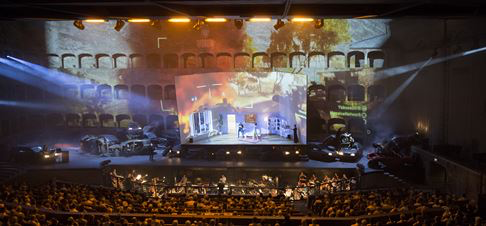 The back wall is the arcades of the Felsenreitschule (Summer Riding School) carved into the Salzburg mountainside that is now part of one of the three adjacent theaters of the Salzburg Festival, plus the wrecked cars and apartment of the production.
The back wall is the arcades of the Felsenreitschule (Summer Riding School) carved into the Salzburg mountainside that is now part of one of the three adjacent theaters of the Salzburg Festival, plus the wrecked cars and apartment of the production.
The Conquest of Mexico is a star vehicle for baritone if ever there was one. In this case it was Bo Skovhus who was Cortez, or in Artaud parlance the male principle. His inherent masculinity was blatant, this is not at all a personal compliment. He climbed through a massive pile of dirty wrecked cars (evidently Mr. Konwitschny’s male principle metaphor) to arrive at a sterile box with a window and a sofa and a door to a kitchen (Mr. Konwitschny’s female principle metaphor to represent Mr. Rihm’s idea of the new world — an opposite world). Montezuma was sung by soprano Angela Denoke whose blond presence was difficult and calculating. It was either rape or it was not but finally it was, the issue of copulation was the neuter world of computer games.
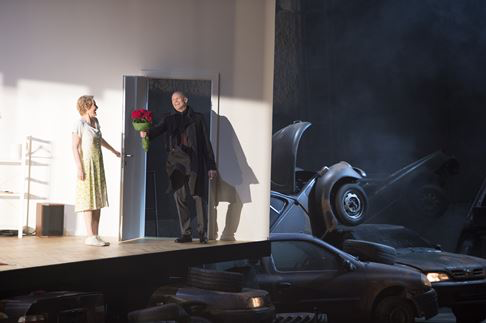 Angela Denoke as Montezuma, Bo Skovhus as Cortez
Angela Denoke as Montezuma, Bo Skovhus as Cortez
Before all festival performances the audience gathers in front of the festival theaters for one last aperitif before the performance. Any performance at the festival is a dressy event but you did notice more than the usual number of men in tuxedos, unusually they were young men (the festival audience is mature). Well, at a certain moment (intense noise) these thirty-one young guys rushed down through the audience, clamored onto and over the wrecked cars and finally crashed onto the stage where they provoked a beer blast, cheered on first male oral sex then the ugly rape, and finally slobbered over six scantily clad mädchen and a shinny red Porsche.
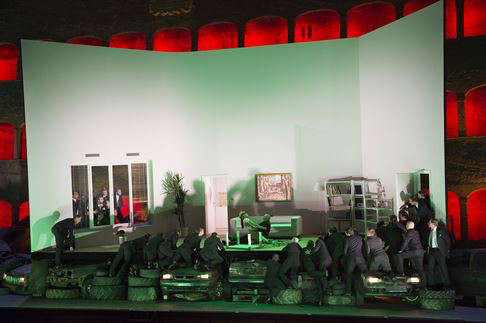 The tuxedo dressed Spanish soldiers
The tuxedo dressed Spanish soldiers
Bo Skovhus killed Angela Denoke (it was that real), then killed himself (in fact this was a very moving, extended scene). But Mr. Skovhus and Mme. Denoke aka Cortez and Montezuma did come together posthumously. They were seated side by side but not touching to sing the a cappella duet that ends the opera, It was the full exposition of Artaud’s neuter.
Did I get all this right?
There was a sizable ensemble of lower voiced instruments in the pit (violas and cellos, bass clarinet, contrabassoon, harp, piano and lots of tom-tom drums, etc. There was a primary conductor, Ingo Metzmacher, plus a second conductor who seemed to be only interested in the stage. There were two far-away orchestras of percussion instruments and brass instruments and a violin seated on an old truck-tire on each side of the wide stage. It was loud, very loud, then louder with a huge compliment of microphones and speakers. It was ugly music. It was meant to be.
In the pit as well were two male Speakers who spent the first part of the evening sitting in the pit making various weird noises with there voices, and a soprano seated in the pit house left who sang very high, freakish notes from time to time, and in the pit on house right a mezzo-soprano sang very low notes from time to time. And from time to time these four singers climbed out of the pit onto the stage, and climbed over piles of tires and wrecked cars to help out Cortez and Montezuma on the stage.
It was a fun evening.
For a formal exposition of the genesis of this work go to the Salzburg Festival website About this production .
Michael Milenski
Cast and production information:
Montezuma: Angela Denoke; Cortez: Bo Skovhus; Soprano: Susanna Andersson; Mezzo-soprano: Marie-Ange Todorovitch; Speaker 1: Stephan Rehm; Speaker 2: Peter Pruchniewitz. ORF Radio-Symphonieorchester Wien. Conductor: Ingo Metzmacher; Stage Director: Peter Konwitschny; Sets and Costumes: Johannes Leiacker; Lighting: Manfred Voss; Video Design: fettFilm; Sound Design: Peter Böhm and Florian Bogner. Felsenreitschule Theater, Salzburg, August 1, 2015.
image=http://www.operatoday.com/Conquest_Salzburg1.png
product=yes
product_title=Die Eroberung von Mexico at the Salzburg Festival
product_by=A review by Michael Milenski
product_id=Above: Bo Skovhus as Cortez
Photos copyright Salzburger Festspiele / Monika Rittershaus
August 7, 2015
Scottish Sensation at Glimmerglass
Surely its raison d'être on the schedule was the availability of bass-baritone Eric Owens, who made a triumphant debut in the title role. Mr. Owens possesses one of the great voices of our time. While he was announced as indisposed, it made no matter as he lavished the part with rolling, refulgent tone and infused it with uncommon intelligence and heartfelt subtext.
He was mesmerizing in his dramatic focus, and his anguish was almost pitiable save for his unhinged commitment to cold-blooded murder. Eric went from strength to strength all evening long, with his gorgeous dusky approach to Pieta, rispetto, amore earning the boisterous ovation it prompted. Macbeth’s tragic death scene (not always performed) was masterfully calibrated, invested as it was with nuance, build and pathos. This was a noteworthy role assumption by a singer at the top of his game.
No less accomplished was the Lady Macbeth of Melody Moore, who set a new gold standard for interpreters of this fiendishly difficult part. Ms. Moore is possessed of a rich, round, gleaming tone that not only caresses legato phrases with ease, but also fires off incisive coloratura and accurate trills seemingly at will. Her take on the role as an aggressive, manipulative spouse, was febrile, feline, fierce and every other manner of F-word.
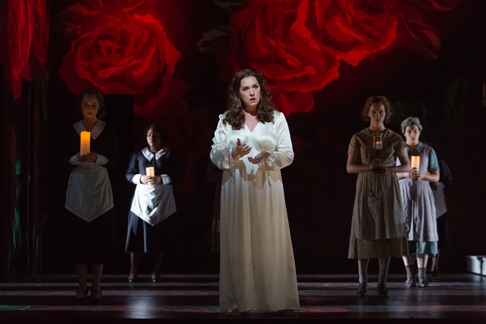 Melody Moore as Lady Macbeth
Melody Moore as Lady Macbeth
Her seething determination in La luce langue, her incorporation of a stooped primal posture, all clenched fists and coiled spring, was electrifying. She almost made you wonder how one so strong could ultimately go so crazy! The haunting, hollow filigree of sound that Ms. Moore summoned in the great Sleepwalking Scene was chilling and utterly secure. Hers was a remarkable achievement.
In that same Sleepwalking scenario, the soprano was ably supported by the distinctive mezzo of Mithra Mastropierro as the Lady-in Waiting, and the warm baritone of Nathan Milholin as the Doctor, both Young Artists of fine promise.
Soloman Howard as Banquo is a young bass of tremendous stature and polish. Mr. Soloman already has the warmth and breadth of tone of a Simon Estes, and the easy, burly spontaneity of a Bryn Terfel. His tall, lean stature conveys an imposing presence, and he internalizes the part, so that we empathize with his character’s concern. Soloman has a potent vocal presence, and his vibrant, imposing, dark tone is even and solid. If the top occasionally gets a bit diffuse, he certainly sings higher phrases easily and convincingly. His rendition of Come dal ciel precipita was another production high point. Soloman Howard is a star on the rise.
Michael Brandenburg has an appealing, pointed tenor with an assured technique and an effortless delivery. A la paterna mano was beautifully intoned, and he certainly has the role in his throat. Now I would only urge him to loosen up a bit emotionally and get it in his heart. Marco D. Cammarota’s meaty tenor has presence, ping, and assertiveness. Both of these fine artists reflect great credit on the company’s Young Artist Program.
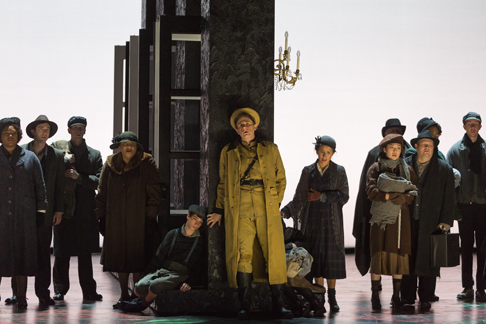 Michael Brandenburg as Macduff
Michael Brandenburg as Macduff
And that program’s fresh, shining voices contributed some pretty impeccable choral singing. Of necessity, the tradeoff is that some maturity and gravity of tone got lost. But Chorus Master David Moody elicited absolutely clean diction and impressive dramatic intent. The outstanding ensemble work had balance and an admirable unity of purpose.
Joseph Colaneri conducted with forward motion and authentic style. The Maestro never over-indulged the bathos and horror. His very brisk opening statements, and pulsing undercurrent to the floated, ethereal strings established his approach to the score. The orchestra exhibited excellent ensemble work, but there were also beautiful solo passages that mirrored the drama on stage. Maestro Colaneri was a willing partner in the breathless finale to the Macbeth-Lady duet as they scurry off stage after the murder of the King. I have heard some wonderful orchestras here over the years, but this was arguably the finest idiomatic playing I have yet heard from Glimmerglass pit.
James Schuette’s Set Design was mysterious yet multi-functional. Center stage is a wall unit that revolves to reveal an exterior and interior of an early 20th Century upscale mansion. It is contained by a box set with three entrance doors on each side, decorated with huge cabbage roses. At times, these images convey hominess and warmth, but at others they chillingly turn blood red thanks to Robert Wierzel’s vibrant lighting design. Mr. Wierzel has conjured up a wonderful bag of tricks, witness the beautiful isolation of Banquo’s ghost, and the stunning effect that makes the set almost look as though it were lit from within.
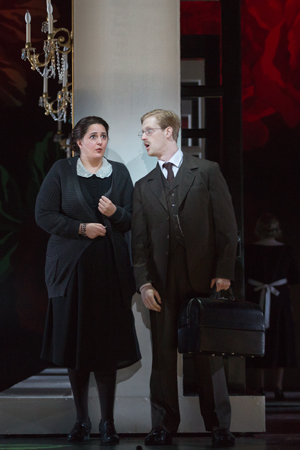 Mithra Mastropierro as Lady-in-Waiting and Nathan Milholin as Servant
Mithra Mastropierro as Lady-in-Waiting and Nathan Milholin as Servant
The upstage walls can part and slide open, facilitating some beautiful backlighting effects, such as the beautiful silhouette of the chorus as they sang Patria oppressa. Mr. Schuette’s and Beth Goldenberg’s effective costumes conveyed station as well as hierarchy. I especially loved Duncan in his snooty top hat, overcoat, and gloves, which he removed deliberately and unctuously passed to the servants.
Director Anne Bogart has devised a personal and pervasive concept for the “Scottish Play.” She seems to have felt that the whole drama is played out in Macbeth’s mind. In the very first scene, the title character and Banquo enter shining flashlights hither and thither as if to look for clarity in the corners of Macbeth’s troubled mind.
One problem with this is (just as Jack Nicholson in The Shining) Macbeth seems kinda nuts from the beginning. He is therefore somewhat robbed of his journey. That said, the flashlight conceit paid off good dividends when Macbeth used it as “the dagger he sees before him.”
I quite liked the surreal concept of the refugee ladies who enter through the house during the prelude, and then become the witches. I wish the concept had gone even further in developing the women as omnipresent symbols. The use of the female chorus as set pieces in the Sleepwalking scene was inspired, with them holding candles as living “columns” that twisted and turned as facets of Lady Macbeth’s twisted mind.
Ms. Bogart forged highly specific character relationships, and facilitated outstanding ensemble work in which everyone seemed to have crafted and sustained an individual persona. The chorus was masterfully used in creating living tableaux.
Perhaps she allowed a bit too much moving about of furniture, which was sometimes brought on only to promptly be taken off again. But I loved her send-up of the soldier extras madly running through the doors of the wall, in a demented child’s game of war as though Macbeth had become totally unhinged.
The directors’ second witches’ prophecy scene was a mastery of groupings, and featured inventive use of props. The procession of primitive ritual dolls, family portraits, crests, et al, to terrorize Macbeth was highly effective, indeed the best solution I have ever seen. I also appreciated the suggestions of primitive ritual, like when the stick-wielding assassins circled Banquo with stylized, ominous motion.
No doubt about it, this Macbeth was a notable jewel in the crown of this 40th Anniversary celebration.
James Sohre
Cast and production information:
Macbeth: Eric Owens; Banquo: Soloman Howard; Lady Macbeth: Melody Moore; Macolm: Marco D. Cammarota; Macduff: Michael Brandenburg; Lady-in-Waiting: Mithra Mastropierro; Doctor/Servant: Nathan Milholin; Assassin: Derrell Acon; Herald: Hunter Enoch; Apparitions: Vanessa, Jasmine Habersham, Rhys Lloyd Talbot; Duncan: Simon Carr-Ellison; Fleanzio: Aiden Delany; Conductor: Joseph Colaneri; Director: Anne Bogart; Choreographer: Barney O’Hanlon; Set Design: James Schuette; Costume Design: James Schuette and Beth Goldenberg; Lighting Design: Robert Wierzel; Hair and Make-up Design: Anne Ford-Coates
image=http://www.operatoday.com/KarliCadel-Macbeth-StageOrch-055.png
image_description=Eric Owens as Macbeth and Soloman Howard as Banquo [Photo: Karli Cadel/The Glimmerglass Festival]
product=yes
product_title=Scottish Sensation at Glimmerglass
product_by=A review by James Sohre
product_id=Above: Eric Owens as Macbeth and Soloman Howard as Banquo
Photo by Karli Cadel/The Glimmerglass Festival
Norma in Salzburg
The Norma herself is Cecilia Bartoli, and she is as well the artistic director of the Whitsun Festival (where, by the way, this next spring she will sing Maria in West Side Story conducted by Gustavo Dudamel). Evidently Mme. Bartoli is as deft a producer as she is a deft Norma.
Bellini’s spectacular old warhorse is a tour de force for a soprano, Mme. Bartoli’s upper extension is well able to handle the high and intense emotional climaxes, her lower chest voice beautifully portrays Norma’s maternal moments, and in between a strong mezzo-soprano sound well sustains the extended lines and slow motion of the likes of “Casta diva.” Mme. Bartoli’s musicianship is exemplary, her coloratura absolutely splendid, achieving in the cabaletta of rage at the end of the second act astonishing vocal turns that are unique to her artistry.
But all of this has been said many times before. It has also been said that la Bartoli is an exemplary producer, not only casting voices that compliment her sound, technique and musicianship but engaging a conductor and orchestra that simulate an early nineteenth century Bellini musical poetic, in this case La Scintilla, a Zurich Opera founded original instrument ensemble. This splendid orchestra makes a far more mellow sound than the sharp, exciting tones of a modern orchestra, its sound supporting, not competing with the beautiful singing that must resolve the truly impossible, indeed ugly situations proposed by the early Romantics.
Mme. Bartoli’s most brilliant choice is however that of stage director, in this case the French team Moshe Leiser and Patrice Caurier who imposed a concept that portrayed a parallel situation and created an atmosphere and a context that in no way updates what little Bellini knew (and we know) of the Druid fertility ceremony. The staging did not attempt to explain, amplify or go beyond the preposterous story the opera tells. It simply told another story from another century simultaneously. Both stories share a crucial theme — consorting with the enemy.
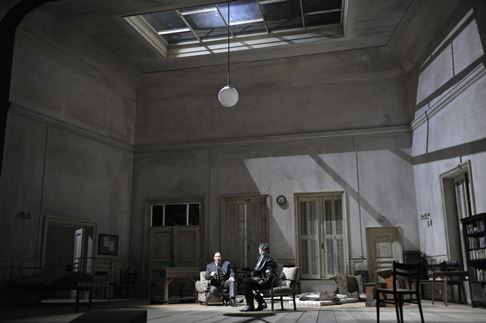 Set design by Christian Fenouillat
Set design by Christian Fenouillat
The mythical Druid world was sung in a school room in Vichy France. It moved to a blank wall, there was a doll in a blanket (an abstraction of Norma’s two children) and finally it returned to the school room that went up in flames. But not before Norma’s hair was hacked off marking her as a sexual collaborator. The ethical conflicts felt by a twenty-first century audience were addressed while the Romanticism of bel canto was allowed to drive naturally to its fiery climax (the fickle lover obviously won over by Norma’s beautiful singing since otherwise his change of heart cannot be comprehended).
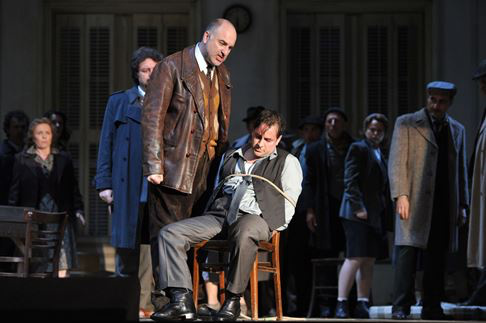 Michele Pertusi as Oroveso, John Osborn as Pollione
Michele Pertusi as Oroveso, John Osborn as Pollione
American tenor John Osborne is an exemplary Pollione, his sound and presence are of the amplitude to hold his own with two over-wrought sopranos, and his is of sufficient tenorial stature to go to his death with real coglioni — Mr. Osborne is able to respect the grace of bel canto and cut a fine figure as a lover as well be a tenor. Zurich Opera trained, Mexican soprano Rebeca Olvera possesses a much lighter voice than Mme. Bartoli. Her Adalgisa is intended to be girlish rather than monastic, she is vocally virginal in contrast to the maternal mezzo Norma. Italian bass Michele Pertusi sings Oroveso using a natural sharpness of voice that easily withholds all possible forgiveness.
Musically the production was in the hands of Zurich based Italian early music conductor Giovanni Antonini who keeps careful control of his orchestral forces to allow the bel canto to soar in the voices of the singers rather than rise from the pit. This Norma is about singing the Druid world as this world was perceived (maybe) by Bellini. And too this Norma is a collision of centuries.
Michael Milenski
Cast and production information:
Norma: Cecilia Bartoli; Adalgisa: Rebeca Olvera; Pollione: John Osborn; Oroveso: Michele Pertusi; Clotilde: Liliana Nikiteanu; Flavio: Reinaldo Macias. Chorus of the Radiotelevisione Svizzera, Lugano; Orchestra La Scintilla at Zurich Opera. Conductor: Giovanni Antonini; Stage Director: Moshe Leiser / Patrice Caurier; Scenery: Christian Fenouillat; Costumes: Agostino Cavalca; Lighting: Christophe Forey. Haus für Mozart, Salzburg Festival, August 31, 2015.
image=http://www.operatoday.com/hires-Norma_Probenfoto_Rebeca_Olvera_Cecilia_Bartoli_c_Hans_Joerg_Michel.png
image_description=Rebeca Olvera as Adalgisa, Cecilia Bartoli as Norma [Photo copyright Hans Jörg Michel, courtesy of the Salzburg Festival]
product=yes
product_title=Norma at the Salzburg Festival
product_by=A review by Michael Milenski
product_id=Above: Rebeca Olvera as Adalgisa, Cecilia Bartoli as Norma
All Photos © Hans Jörg Michel, courtesy of the Salzburg Festival.
August 5, 2015
The power of music: a young cast in a semi-stage account of Monteverdi’s first opera
This was far more than a mere concert, performed from memory by the choir and a team of young soloists includingKrystian Adam as Orfeo, Mariana Flores as Eurydice and La Speranza, FrancescaAspromonte as La Musica and La Messagera,Gianluca Buratto as Caronte and Plutone,Francesca Boncompagni as Proserpina,Andrew Tortise, Nicholas Mulroy, Esther Brazil, Gareth Treseder, James Hall and David Shipley, this was a full staging with action and dancing taking place on the platform in and around the instrumentalists.
The vast expanse of the Royal Albert Hall is, frankly, not the most sensible place to perform a work like L’Orfeo. It demanded, and received, intense concentration from the audience. John Eliot Gardiner used quite large forces, with a choir of over 40 (including eight members of the Monteverdi Choir Apprentices Programme). The soloists were also in this group with most stepping out to sing their roles. The orchestra numbered some 30 people, but the moments when they were all playing was very rare and much of the vocal line was accompanied by the continuo group of harpsichord, organ, harp, cello and four chitarrones.The peculiar effect of the acoustic could be heard in the opening toccata when the cornetts and sackbuts filled the hall, leaving the other instruments virtually inaudible.
Monteverdi Choir with Krystian Adam in the foreground
John Eliot Gardiner is a veteran of Proms performances and understands how to make the Royal Albert Hall work. His tempos allowed space for the music to develop and it was noticeable that he directed all the music, even the smaller scale sections where in a smaller venue the conductor would be redundant. But Gardiner’s speeds seemed as if they were also a personal choice, this felt like a performance where we were being encouraged to stop and smell the daisies. There was a consistently relaxed feeling, and a constant sense of allowing space for the elaborate vocal lines to flourish. The great moments such as Orfeo’s Possente spirto possessed a mesmerising beauty and a sense that the incredible ornament was really part of the music, but they completely lacked urgency and a feeling of the drama progressing. L’Orfeo is an opera in which very little happens and we did rather lose the sense of a dramatic narrative. This was perhaps one of the longest performances I have experienced, lasting well over two hours if you include the pauses for re-tuning with well over 110 minutes of music.
This was very much an all singing, all dancing production. Mariana Flores and Francesca Aspromonte took a lively part in the dancing during Acts One and Two, and there was no sense that this staging was ‘semi’, it fully occupied the stage. No director or choreography was credited, but the singers all used a rather stylised gestural language which, in a performer like Krystian Adam, I started to find mannered rather than expressive. One of the strengths was the intense way the smaller roles were characterised, the various nymphs, shepherds and spirits who step out from the chorus and then retire. Here they became a strong part of the drama.
For me the most thrilling moment was the opening, with the Prologue sung by Francesca Aspromonte as La Musica. She sang with daring slowness, but made every single note and phrase tell despite quite a slim-line voice. Having a number of native Italian speakers in the cast meant that this was a production in which the text really did mean something, and we certainly didn’t need surtitles. Rather neatly Aspromonte accompanied herself (very creditably) on a guitar at one point. Not every singer managed to make such a strong impression, but when Aspromonte returned as La Messagiera she was equally vivid, though here she was forced to deliver the solo whilst walking through the promenaders accompanied simply by an ambulant chitarrone player.
Mariana Flores and Francesca Aspromonte (dancers)
Mariana Flores was a charming, soft-grained Eurydice who never quite managed to make a strong impression musically and rather over-acted her love for Orfeo to compensate. She made a poised La Speranza.
Krystian Adam as Orfeo was of course the centre of attention. Adam did not sing to the hall, and forced everyone to concentrate, to centre their attention on him. It was a performance well worth concentrating on. He has a lovely, flexible soft-grained lyric voice and had clearly though about the intensely elaborate vocal line so that it had a naturalness to the way it sat in his voice. Possente spirto was completely mesmerising, and time really did stop. Fatally so, in that we often seemed to lose a sense of dramatic urgency. But this was one of the most beautiful accounts of the role that I have ever heard.
Gianluca Buratto was a wonderfully dark voice Plutone and Caronte. Finely implacable as Caronte, he revealed ultimately a softer side as Plutone. Here he was aided by Francesca Boncomopagni’s elegant, slim-voice but highly expressive Proserpina.
The smaller roles were all very finely taken. Esther Brazil stood out as the Nymph, whilst Andrew Tortise effortlessly commanded both the music and the stage as Shepherd I and Apollo. I am a little unclear who played whom for the rest, as I think the programme got things wrong. Gareth Treseder was credited as Shepherd 2 and Spirit 2, with Nicholas Mulroy as Spirit 1, but I think that it was the other way round. No matter, they and James Hall and David Shripley, produced some vivid and highly characterised singing.
The Monteverdi Choir were in superb form, singing with a lovely flexibility and vividness. The performance was almost worth it for them alone, and the lightness of their performance belied the large number.
All were well supported by Sir John Eliot Gardiner and the English Baroque Soloists. Inevitably in a venue as large as the Royal Albert Hall the individual solo instrumental contributions can blur, but the overall effect was a stunning riot of virtuoso technique and orchestral colour.
Sir John Eliot Gardiner presided over a profoundly beautiful, and strongly characterised account of the score. There were some glorious moments, and this was very much about the power of music. But, for me, Gardiner’s approach robbed it of the underlying dramatic urgency that the plot needs.
Robert Hugill
Cast and production information:
Orfeo: Krystian Adam, Eurydica/La Speranza: Mariana Flores, La Musica/La Messagera: Francesca Aspromonte, Caronte/Plutone: Gianluca Buratto, Proserpina: Francesca Boncompagni, Andrew Tortise, Nicholas Mulroy, Esther Brazil, Gareth Teseder, James Hall, David Shipley.Monteverdi Choir, English Baroque Soloists, Sir John Eliot Gardiner. BBC Proms at the Royal Albert Hall, 4 August 2015.
image=http://www.operatoday.com/Gardiner.png image_description=John Eliot Gardiner [Photo by BBC/Chris Christodoulou] product=yes product_title=The power of music: a young cast in a semi-stage account of Monteverdi’s first opera product_by=A review by Robert Hugill product_id=Above: John Eliot GardinerPhotos by BBC/Chris Christodoulou
August 3, 2015
Cold Mountain Wows Audience at Santa Fe World Premiere
The librettist was Gene Scheer who wrote texts for Jake Heggie’s Moby-Dick as well as Tobias Picker’s Thérèse Raquin and An American Tragedy. Scheer based his libretto for Cold Mountain on Charles Frazier’s historical novel of the same name. Higdon has successfully redirected her formidable efforts from the symphony to the theatre, and in doing so has produced a most memorable first opera. Not only do her vocal lines underline the personalities of each character, they are melodic, witty at times, and generally reflect the time and place of the setting.
Although director Leonard Foglia told his tale with occasional flashbacks, the action generally surged forward to capture the emotional punch of the novel. Robert Brill made his scenic design of dark boards juxtaposed at various angles. With the addition of Brian Nason’s lighting and Elaine J. McCarthy’s projections, they could be made to resemble land, sea, and the star-filled sky. David C. Woolard’s costumes were accurate as to time and place.
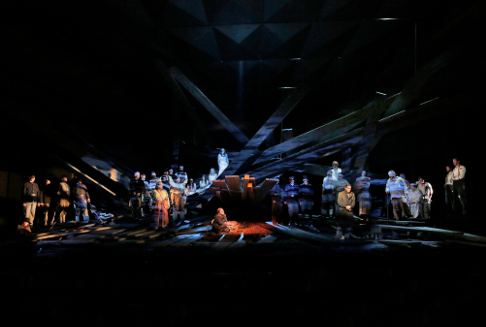 Ensemble cast
Ensemble cast
Baritone Nathan Gunn sang the leading role of W. P. Inman, a wounded infantryman who deserts the Confederate army in an desperate effort to make his way back to Ada, his beloved. Gunn’s large, warm, resonant voice endeared him to listeners from the very beginning of the opera and the audience felt a loss when he died. As Ada, Isabel Leonard was a well brought up young lady who, in Act I, had no knowledge of how to survive in wartime. Her light, lyric mezzo-soprano voice denoted her youth and occasional exuberance, but it was not until the second act that she solidified her portrayal. It was the darker-voiced mezzo-soprano, Emily Fons, who created an immediately recognizable character in her depiction of the edgy, strong-willed Ruby. With golden sounds that included an opulent mid-range, she sang that her only teacher was hunger while she taught Ada how to live off the land and plan for a Spartan future.
Many artists portrayed smaller parts in this panoramic opera. Kevin Burdette was a notable blind man and a selfish deadbeat dad. Roger Honeywell gave a nuanced dramatic performance as Veasey, whose boat seemed to capsize in the air, dumping him and Inman into the dark of night. As Lucinda, whom Inman found hunting for valuables on the bodies left to rot on the battlefield, Deborah Nansteel sang with formidable vocal power while expressing the desperation of a runaway slave.
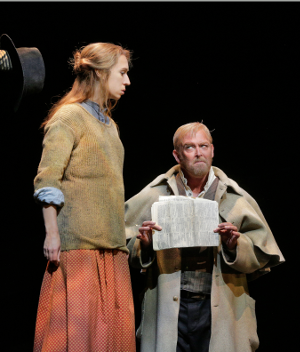 Emily Fons as Ruby and Jay Hunter Morris as Teague
Emily Fons as Ruby and Jay Hunter Morris as Teague
Although tenors are usually heroes who get the girl, Teague, sung with great gusto by heldentenor Jay Hunter Morris, was a murderous villain who continually tried to cause trouble for anyone who did not support ideas of the Confederacy. Morris proved to be a singer whose bronzed tones could enchant an audience while they resonated with evil. Surprisingly, in the end it was not Teague who killed Inman, it was the young boy he had trained to carry on his violent work.
Some of the music of Cold Mountain hit the audience directly in the solar plexus. One of its most stirring moments took place when the dead soldiers who said they had long been forgotten, rose from their graves to tell the audience what they died for. Chorus Master Susanne Sheston’s male apprentices sang with nuanced dramatic power:
“Buried and forgotten
In our beautiful country
Where we lie buried We rest beneath every step you take,
In the dust, in the ground on which you tread.”
Conductor Miguel Harth-Bedoya led an orchestra of interesting proportions that offered pungent harmonies and displayed an enormous tapestry of musical color thanks to the inclusion of considerable brass and percussion. Currently, the opera is being recorded by the Dutch label, PentaTone. Since Cold Mountain’s five scheduled Santa Fe performances sold out early, a sixth one has been added.
Maria Nockin
image=http://www.operatoday.com/2%20Isabel%20Leonard%20%28Ada%29%20and%20Nathan%20Gunn%20%28Inman%29%20in%20%E2%80%98Cold%20Mountain.%E2%80%99%20Photo%20%C2%A9%20Ken%20Howard%20for%20Santa%20Fe%20Opera.png
image_description=Isabel Leonard as Ada and Nathan Gunn as Inman [Photo by Ken Howard]
product=yes
product_title=Cold Mountain Wows Audience at Santa Fe World Premiere
product_by=A review by Maria Nockin
product_id=Above: Isabel Leonard as Ada and Nathan Gunn as Inman
Photos by Ken Howard
August 1, 2015
Review: You Promised Me Everything
It’s a phrase which seems to encapsulate Cheryl Frances-Hoad’s modern-day engagement with the music of the yesteryear, as represented by the compositions which comprise this CD, You Promised Me Everything, which express a gamut of human emotions and complexities with startling dramatic impact. The CD, released in 2014, represents 10 years of writing for the voice and for choirs, and includes Frances-Hoad’s first choral work, There is no rose, composed when she was a teenager, and her first BBC commission, Beowulf (2012), a ‘miniature opera’ for soprano and piano.
One Life Stand (2011) for mezzo soprano and piano epitomises the wonderful inventiveness and persuasiveness of Frances-Hoad’s response to iconic compositions of the past, and the thoughtfulness and acuity of her text setting. The eight songs of Schumann’s Frauenliebe und Leben (Women’s Live and Loves) describe a woman’s love, from her point-of-view, from her first meeting with her beloved, through marriage, to her husband’s death and beyond. Apparently prompted by singer Jennifer Johnston’s remark that the nineteenth-century perspective of Chamisso’s poems was now rather outdated, Frances-Hoad has revisited a woman’s ‘one life stand’ through settings of eight poems by the crime writer Sophie Hannah, and has created a musical narrative which spans from the first bloom of passion to the grief of bereavement.
From the two rocking chords which form the opening bars of the piano accompaniment of the first song, ‘Brief Encounter’, there is a sustained conversation between the accompaniment and voice, and a diversity of texture that is a worthy homage to Schumann. Jennifer Johnstone’s line is pure and eloquent, her intonation dead-centre: the melodic arcs soar above diverse scintillating piano textures and figurations which are articulated with bright clarity by Joseph Middleton. The harmonic language beguiles with Romantic sumptuousness at times but is never indulgent, and unaccompanied vocal phrases both isolate sentiments and add sincerity.
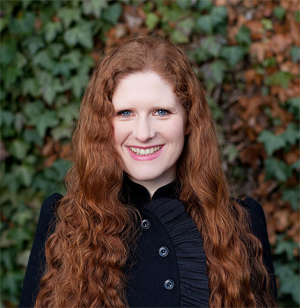 Cheryl Frances-Hoad
Cheryl Frances-Hoad
There is humour too: indeed, the titles of the songs often speak drolly: ‘The Pros and the Cons’, ‘The Ante-Natal’, ‘Rubbish at Adultery’. And, this is echoed in musical details such as the brusque, quiet perfect cadence which closes ‘The Pros and Cons’, wriggling piano accompaniment to ‘Rubbish at Adultery’ (meticulously executed by Middleton), and the dry chordal accompaniment which punctuates with wry emphasis the text of ‘The Ante-natal’:
‘My husband doesn’t want to hold the plastic pelvis model.
He tells the other husbands that it’s bound to be a doddle.
He thinks the role of classes is to teach, not mollycoddle.
He’ll go so far, but not an inch beyond.My husband is afraid of meeting women called Magenta,
Of sharing wholesome snacks outside the Early Learning Centre,
Of any exercise that’s an incontinence preventor.’
I was reminded, in terms of both the text setting, vocal flamboyance, and pithy accompanying gestures, of Britten’s Cabaret Songs of 1937-39 — indeed the neatness of the rhymes seems to match Auden’s wry verbal dexterity: ‘My husband mocks the books with their advice about nutrition,/ He shocks the other couples in the coffee intermission.’
In contrast, ‘Tide to Land’ has a rolling melodicism which recalls the songs of Gerald Finzi, underpinned as this song is first by linear, exploratory textures and harmonic inflections, and then by repeating chords in the keyboard. Johnstone securely negotiates the abrupt changes of register, and her lower voice has a soft beguiling quality; she wraps her alluring mezzo around the elegiac lines most beautifully. But, there is darkness, too, at the start of ‘Shadow Tree’, in the ominous, slow, low- and close-registered piano chords which seem to compress emotion; and, the distance between the cloudy accompaniment and floating vocal line isolates the voice in loneliness — this song is the emotional centre of the cycle. Here and elsewhere the melodic poise, elasticity and naturalness recall Britten vocal lines in works such as the early Hymn to St Cecilia, and the later canticles.
The gentle reticence of the textures and harmonic language of ‘In the Chill’ — which contrast with intermittent expanses of volume and density — movingly convey the destabilising unpredictability and impact of loss. The final song, ‘The Cycle’, begins with contained but agitated figures in the piano which ascend to the highest registers, plucking at the nerve-strings. There is restlessness in the rippling arpeggios which follow as the voice seems to strive upwards, futilely seeking resolution, frustrated yearnings as the music repeatedly breaks off into silence. In conclusion, however, there is some consolation, with the return of the rocking chords of the first song ‘Brief Encounter’: perhaps one woman’s song of life and love belongs to us all, ever to be repeated.
Frances-Hoad studied at the Menuhin School and then at Cambridge University with Robin Holloway, before completing a Ph.D. at King’s College London with George Benjamin and others. Several of the works on this disc were commissioned by Geoffrey Webber and Gonville and Caius College, Cambridge, and are performed here by the College choir.
Psalm 1 for choir and organ (Nicholas Lee) was commissioned to celebrate the 800th anniversary of Cambridge University and was first performed in May 2009; the work won Frances-Hoad a BASCA British Composer Award in 2010. The opening seems to be reassuringly posited in the line of the English choral tradition: the harmony leans towards diatonicism, a single sustained note played by the organ anchors the rich flowing voices, and the ‘open’ sound once again recalls, for me, early Britten. But, the theatrical interruption of a disjunctive parlando for male voices, punctuated by dissonant quasi-screams by female voices, is disturbing, as the text moves from an account of the virtuous to the ungodly, and the work closes ambivalently and disconcertingly, unresolved intervals fading into a dark void: the wicked shall surely perish.
Soprano Rose Wilson-Haffenden’s stratospheric solo which commences Frances-Hoad’s Nunc Dimittis (2000) for 21 a capella voices is stunning: crystalline, penetrating, mesmerising. Brief this three-minute work may be but there is no shortage of intensity and range: as the accumulating voices cascade, rebound and then retreat, Frances-Hoad’s sensitivity to the text is once again confirmed. The solo soprano’s final, ecstatic high C shines like a starlight into the cosmos. There is no rose won Frances-Hoad the Bach Choir Carol Competition in 1995 and was premiered by the choir at the Albert Hall that year. Again there is a debt to Britten; yet, the composition shows an astonishing command of textural and harmonic nuance, and such subtleties capture the both the meditative and exhilarating qualities of the text.
Frances-Hoad does playfulness as well as she does piety and pathos though. Don’t (2009) was dedicated to soprano Jane Manning for her 70 th birthday and sets text compiled from Blanche Ebbutt’s Don’t’s for Wives (1913) — a handbook containing hundreds of snippets of entertaining advice for a happy marriage that has more comedic value than useful matrimonial guidance: for example, Ebbutt urges that a wife should forbid her husband to wear ‘a violet tie with grass green socks’ and instructs, ‘Don't expect to know your husband inside and out within a month of marriage. For a long time you will be making discoveries; file them for future reference’. Manning has just the right balance of vocal precision and dramatic insouciance; as she journeys to registral extremes, her soprano interacts ironically with laconic contributions from piccolo (Robert Manasse) and bass clarinet (Sue Gill), coolly conveying an air of self-deluding sincerity. The repeating hymnal plagal cadences of You Promised Me Everything Last Night (2011) for soprano, piano four hands and cello (performed here by Natalie Raybould soprano, James Young and Joseph Middleton piano and Rebecca Knight cello), together with the anchored vocal line which after each soaring foray returns to its starting point, seem to underscore the romantic clichés of the text. But, just as one settles into the familiar, Frances-Hoad nudges the listener from the groove: the voice strays off pitch, from melody to speech, and into breathlessness; the piano adds dissonant coloration. It’s clear that, unnervingly, these six words (the subtitle is ‘six words, two chords, many melismas’) conjure more possibilities and avenues than one imagined.
The CD concludes with Frances-Hoad’s 30-minute Beowulf for mezzo-soprano and piano, which was premiered in 2012 by Jennifer Johnston at the City of London Festival, and in which the composer re-explored the Anglo-Saxon poetry which she had set in her song-cycle The Glory Tree (the title track of her first Champs Hill CD, 2011). The narrative of the ancient text isabbreviated and tells of Beowulf’s two fights, with Grendel and with the dragon, set within a prologue and epilogue. The sparseness of the musical writing — announced by the clanging open fifths (piano, Alisidair Hogarth) of the first section, ‘So’, and the recitative-like directness of the vocal line (a magisterial Johnstone, who demonstrates enormous expressive and physical stamina) — has an epic quality, as if drama and expression are pared down to the bare bones. There is a frightening intensity in sections such as ‘Then his rage’: the rhythmic and melodic hairs are all on edge. Hogarth’s complex piano never overpowers Johnstone’s utterances though, which possess an elemental energy, and the piano’s airy asymmetrical motifs in ‘Hildeburgh’ are suave and propulsive. Frances-Hoad provides structural balance: there are episodes of reflection and restraint, and ‘When Hrothgar arrived’ is characterised by a lower tessitura (showcasing Johnstone’s rich chest voice) and tight oscillations of chords in piano accompaniment. The piano interlude mid-way allows for a drawing of breath. After the initial furious conflicts, the tone becomes more fatalistic and Johnstone succeeds in capturing the shifting moods as, after the assertive bravura of ‘Then he drew himself up’, the narrative sinks into the anguish, and quiet dignity, of the concluding declamatory episodes and final unaccompanied measures. This composition makes one long for a full-scale operatic work from Frances-Hoad.
With the exception of There is no rose, these recordings were all made either in the 160-seat concert hall at Champs Hill, the home of David and Mary Bowerman, or in Emmanuel College Chapel, Cambridge, and the recording quality is superb; there is an excellent balance between solos and ensemble, voice and accompaniment, and the sound is clean and bright but not too ‘near’. The CD is carefully packaged and presented with a detailed and informative booklet article by Malcolm MacDonald, and full biographies of all of the talented and committed musicians who perform. (One small quibble might be that no texts are provided.)
Frances-Hoad’s catalogue of honours is long and growing: she won the BBC Lloyds Bank Composer of the Year award when she was just 15 and the Mendelssohn Scholarship, The Bliss Prize, The Cambridge Composers Competition, The Robert Helps International Composition Prize (USA), The Sun River Prize (China), The International String Orchestra Composition Prize (Malta), The RPS Composition Prize, and the BASCA British Composer Awards (where she became the youngest composer to win two awards in any year for Psalm 1 and Stolen Rhythm in 2010) have followed. She has received two awards from the PRS Women Make Music Fund (for The Madness Industry, a brass quintet for Onyx Brass, and Sailing to the Marvellous, a 90-minute oratorio for four choirs and ensemble for Bridlington Priory) and has held the posts of Leverhulme Musician in Residence (at the University of Cambridge Psychiatry Department (2008)), Rambert Composer in Residence (2012/13), and Opera North/Leeds University Cultural Fellow in Opera Related Arts (2010/12).
But, more impressive still is the profusion and profundity of her musical invention, and the distinctive quality of her musical voice identity: on the strength of this CD, it’s clear that Frances-Hoad is able to fuse Romantic and Modernist sensibilities and to composer music which sings with naturalness and honesty which communicates richly and deeply.
Claire Seymour
You Promised Me Everything — Vocal and choral works by Cheryl Frances-Hoad
Rose Wilson-Haffenden, Natalie Raybould, Jane Manning (soprano), Jennifer Johnston (mezzo-soprano), Robert Manasse (piccolo), Sue Gill (bass clarinet), James Young, Joseph Middleton, Alisdair Hogarth (piano); Gonville and Caius College Choir/Geoffrey Webber; Nicholas Lee (organ). Champs Hill Records, CHRCD057 (79:43)
image=http://www.operatoday.com/CHRCD057---Cheryl-you-promised-me-everything---Cover_0x450.png image_description=Champs Hill Records CHRCD057 product=yes product_title=You Promised Me Everything — Vocal and choral works by Cheryl Frances-Hoad product_by=A review by Claire Seymour product_id=Champs Hill Records CHRCD057 [CD] price=$17.99 product_url=http://www.arkivmusic.com/classical/album.jsp?album_id=1506766
Manon Lescaut, Munich
What is Manon Lescaut really about? The Abbé Prévost’s 1731 narrative was a moral discourse. Unlike many modern novels, it wasn’t a potboiler but a philosophical tract in which the protagonists face moral dilemmas.
In this production, key excerpts from Prévost are shown at critical points, not just during the Intermezzo. These are important because they underline the origin of the opera, and its deepest values. The staging is black and white, lit like an interrogation room, for such is its fundamental rationale. It’s not a potboiler, not sentimental. but an uncompromising warning against the seduction by false values like wealth, glitz and short term shallowness. It says much about some audiences that they’d prefer things the other way round.
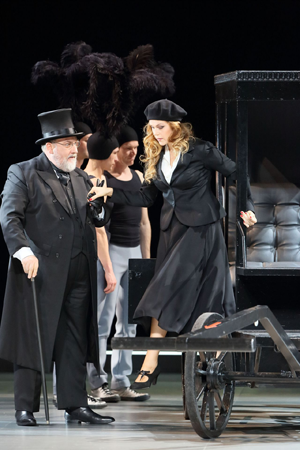 Roland Bracht as Geronte di Ravoir and Kristine Opolais as Manon Lescaut
Roland Bracht as Geronte di Ravoir and Kristine Opolais as Manon Lescaut
Hans Neuenfels’s production, with designs by Stefan Meyer, captures the spiritual state of flux that is so much part of Puccini’s opera. The action moves from place to place but the underlying theme is bleak. The journey starts at Amiens, a faceless place where everyone’s en route to somewhere else. One characteristic of Neuenfels’s style is the way he uses crowds. In his Lohengrin for Bayreuth (read more here), the people of Brabant were shown as rats, since rats conform, but Neunfels treated them not as vermin but with sympathy and warmth. In Manon Lescaut, the townsfolk have garish makeup suggesting Georg Grosz-like malevolence beneath their well-padded uniforms. Anonymous figures appear, zipped up in body bags. Not “belle, brune et blonde” but dehumanized creatures, being trafficked, presumably to America. Suddenly, the casual, flirtatious bantering feels dangerous.
Neunfels’s use of crowds also serves to highlight the central characters. Des Grieux (Jonas Kaufmann), Manon (Kristine Opolais) and Lescaut (Marcus Eiche) stand out in sharp black and white, in full focus. This is luxury casting, and so they should shine. Kaufmann and Opolais “own” these roles these days If anything, they were singing with even greater intensity than they did at the Royal Opera House production last year. Kaufmann’s portrayal was exceptionally deep, enhanced by Neuenfels’s emphasis on the moral and philosophical basis of Des Grieux’s dilemmas, which are inherently dramatic in themselves.
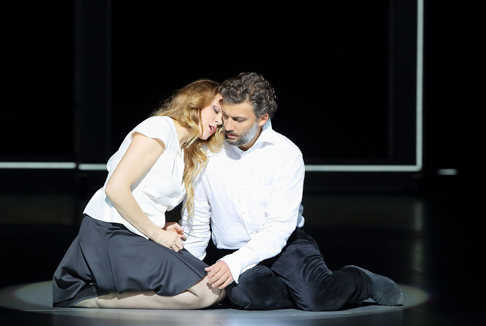 Kristine Opolais as Manon Lescaut and Jonas Kaufmann as Il Cavaliere Renato des Grieux
Kristine Opolais as Manon Lescaut and Jonas Kaufmann as Il Cavaliere Renato des Grieux
In most productions, Manon’s beauty steals the show. When Anna Netrebko pulled out of the part, many sighed with relief, since Opolais has the artistic courage not to need to be seen at her finest. When she sings, she creates a real Manon with all her insecurities and complexities. She dares depict Manon’s inner ugliness, because she can also show her true beauty. Opolais may look tense in the first act and ravaged in the last, but that’s all the more reason to admire her integrity. As she lies on the hard, bare stage that depicts the spiritual desert that is New Orleans, (where physical deserts don’t exist), with her face gaunt and the dark roots in her hair showing, Opolais’s voice transcends her surroundings. Manon is a true hero because she changes, develops and learns true meaning.
The staging of the Paris Act makes or breaks any production, since it confronts the obscenity of Manon’s situation as, frankly, a one-man prostitute. The stage shrinks, lit by a frame of light suggesting a prison without bars, with cut glass objets de luxe symbolizing hard but fragile transparency. All is delusion, the makeup, the madrigals, the dancing. Geronte (Roland Bracht) fancies himself an artist. His friends and Abbé’s aren’t fooled. They’ve come to perve at Manon’s body. In London, many in the audience were aghast that the scene was shown as live porm, but that’s exactly what it is, a rich man showing off to dirty old men like himself. It’s not meant to be pretty, as any reading of Puccini’s score makes clear.
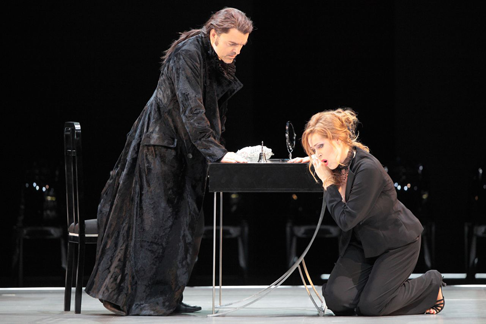 Markus Eiche as Lescaut and Kristine Opolais as Manon Lescaut
Markus Eiche as Lescaut and Kristine Opolais as Manon Lescaut
Neuenfels shows Geronte kissing Manon’s naked leg. The Dancing Master is depicted as an ape, which adds even more horror. Yet Neuenfels also shows that the Dancing Master and Manon have much in common, both reduced to performing animals by the corruption of wealth. Geronte’s friends and, signifcantly, Abbés, supposedly celibate holy men, are dressed as cardinals in fuschia pink. This is not casual detail, for it connects to the brutality of a society that reveres woman as virgins, but objectifies them as sexual creatures to be abused and disposed of.
At Le Havre, Manon is seen in anonymous grey. The gloating crowd with their red wigs now seem demonic,as they are indeed, since they’ve come to enjoy seeing the degradation of women as prisoners. In contrast, the Sergeant seems more human, since he lets Des Grieux slip aboard, no doubt breaking rules. By the time we reach the all-impotant final act, all external trappings are disposed of, too. Manon and Des Grieux are alone, in almost cosmic isolation. All distractions stripped away, Kaufmann and Opolais can release emotions through the sheer power of their singing. Divested of material things they transcend the world itself.
Superlative conducting from Alain Altinoglu, too, leaner than Pappano, but more suited to this elegant, austere conception. Of the three Manon Lescauts in the last two years London, Baden Baden and Munich, this new production is by far the most incisive and intelligent. Good opera goes far beyond the first line in a synopsis. As Manon learns, life isn’t about glitzy trappings, but about human emotion.
Anne Ozorio
image=http://www.operatoday.com/csm_FG_Manon_Lescaut_15_ff46ff85ad.png image_description=Kristine Opolais as Manon Lescaut and Jonas Kaufmann as Il Cavaliere Renato des Grieux [Photo courtesy of Bayerische Staatsoper] product=yes product_title=Manon Lescaut, Munich product_by=A review by Anne Ozorio product_id=Above: Kristine Opolais as Manon Lescaut and Jonas Kaufmann as Il Cavaliere Renato des GrieuxPhotos courtesy of Bayerische Staatsoper